Swedish train driver’s everyday
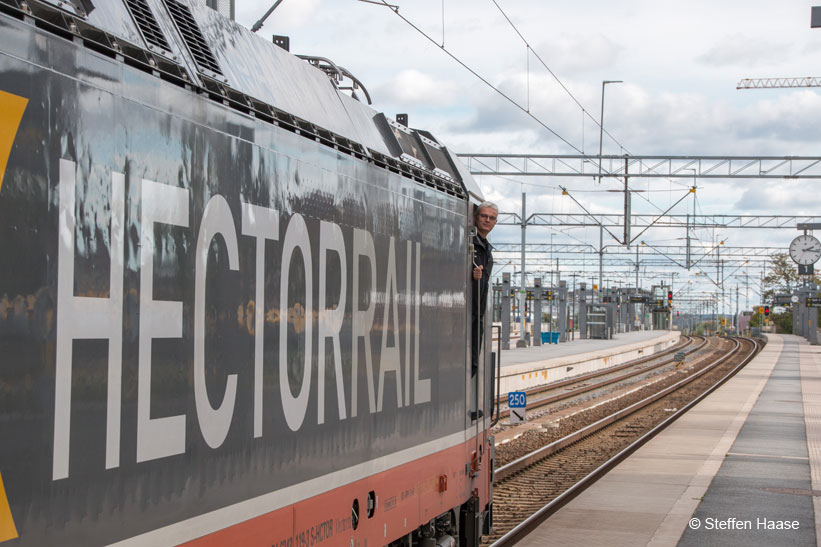
Me looking out of the driver's cab on the Vectron-loco 243.119 in Uppsala on the 24 September 2018. Photo: © Steffen Haase.
What’s a train driver’s
everyday like? Well, it depends of course on where and whereto one is driving,
and with what kind of traction, and also in great extent on the employer. One
thing is sure, though: It’s a difficult job that seems easy!
Are you interested in applying for a job as train driver in Sweden? There are several qualifications one has to fulfil. First, speaking and writing fluent Swedish is necessary. There are several language courses, among them Svenska för invandrare (SFI), i.e. Swedish for immigrants. The Swedish Transport Agency has rules for health, and basic qualifications. Several institutes and schools offers train driver courses, e.g. Yh-educations, paid courses at (some of) the TOCs, etc.
My opinion is, that an already trained train driver from an English
speaking country, fulfils the basic qualifications, apart from the language
knowledge, maybe. If you are a holder of an European Train Driver Licence, it will make it a bit easier easier for
European train drivers applying for a job in another country, as you don't need to do the complete basic training again, but still there are lot's of national requirements, e.g. Swedish safety regulations, signals, training on the specific train and locomotive types, route knowledge etc.
I’ve been a train
driver since 2001, when I was employed by Citypendeln,
the Commuter TOC in Stockholm at that time. Before that, I was also driver at the Lidingö line, one of
the local light rail lines around Stockholm. After almost three years at Citypendeln, I switched over to DB Regio Sverige AB, a Swedish subsidiary to the German
railways Deutsche Bahn AG (DB). I
mainly worked with technical, operational and safety support regarding the X420 EMUs.
During my time at DB Regio, I kept my train
driver license up to date, as the handling of the trains was an important part
of my job. I was also involved in the bidding projects for the Stockholm commuter trains
and the Öresund regional trains.
From August 2006 until October 2010, I worked as train driver at Swedish State-owned SJ AB in Stockholm.
I am licensed to drive the Rc3 and Rc6 electrical locomotives, the high speed
train X2(000), the double-decker EMU X40, the ‘Regina’-EMU (X50-54), the new X55 EMU and the AFM7 driving trailer. I was driving the Uppsala commuter train services, Intercity-trains to the Dalarna, Hälsingland and Värmland counties, regional trains around Lake Mälaren, and
SJ 2000/SJ 3000 services to Gävle, Gothenburg, Falun, Jönköping, Linköping and Sundsvall. From October 2010 to December 2014, I worked as Safety co-ordinator direct under the local management.
Normally, my days were filled with rules and regulations, investigations and risk analysies, but I kept my licens as train driver up to date, taking a shift at least once a month.
During 2015 I was Instructor at the new TOC MTR Express in Stockholm. Since the 21 March 2015, the red express EMUs are running in competition with State-owned SJ on the Stockholm to Göteborg Main Line with the X74-EMUs (Stadler FLIRT Nordic).
I then swirched ower to the freight TOC Hector Rail. I started in January 2016 as Teamleare Instructors, contiued later as Head of Training Department, and since February 2018 I work as Operations Standards Manager. The last puzzle piece in my train driver career is now in place; Freigt trains! I'm driving the battery powered "loco tractor" 021 (Zephir LOK 1390 E), the diesel locos 841 (former SJ T43) and 921 (former SJ Z70), the electolocos 143 (former SJ-Rc3), 241 (Bombardier TRAXX F140 AC2, ergo BR 185), the 242 (Siemens ES64 U2 Taurus), as well as the 243 (Siemens Vectron).
Here, I’m going to show some pictures from my
everyday as train driver, with some complementary text.
The Lidingö line
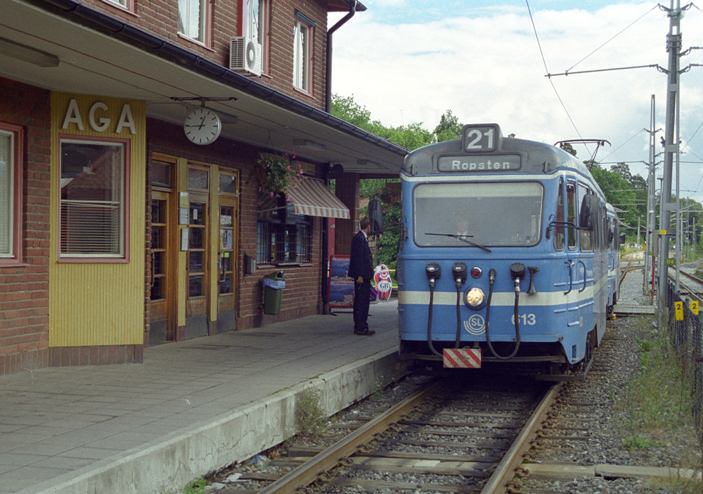
Change of staff at Aga station, on 7 September
1997. I’m going to release my colleague JS on train 2 from his duties, and take
the train further on to mot Stockholm-Ropsten. We’ve
been following each other during the years, today we are fellow colleagues at SJ in Stockholm.
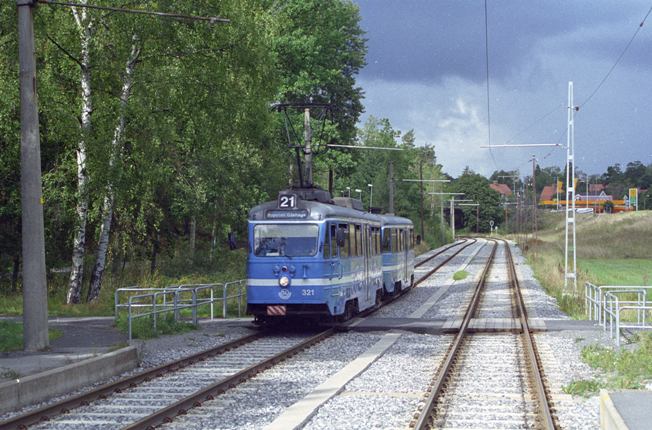
On the way to Ropsten, I passed one of the other
trains at Bodal halt, on the double track line.
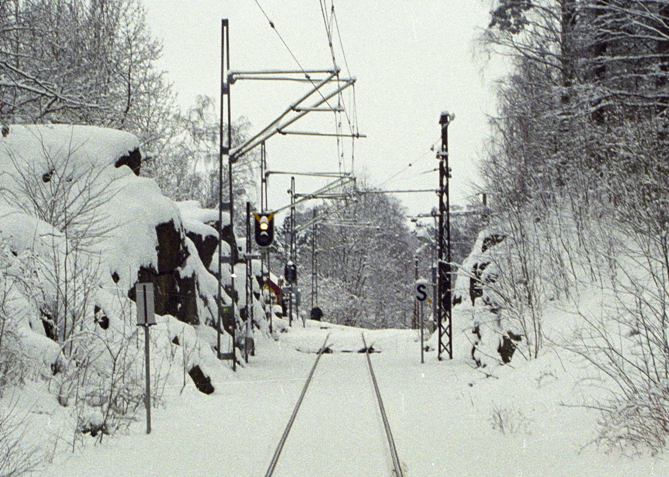
The entry to Baggeby station on the Lidingö line on 8 March 1998. Here, you
can see the unique ‘Point signal’, which showed a white light, when the point
was in control. The double track line hadn’t any track circuits at that time,
apart from a short part just before the Larsberg
halt, which became a block signal after an accident in the 1970’s. During the
summer of 1998, the signal system and the overhead catenary on the were upgraded, and since then the light rail line is equipped with CTC, bidirectional block system etc.
The Stockholm Commuter Trains
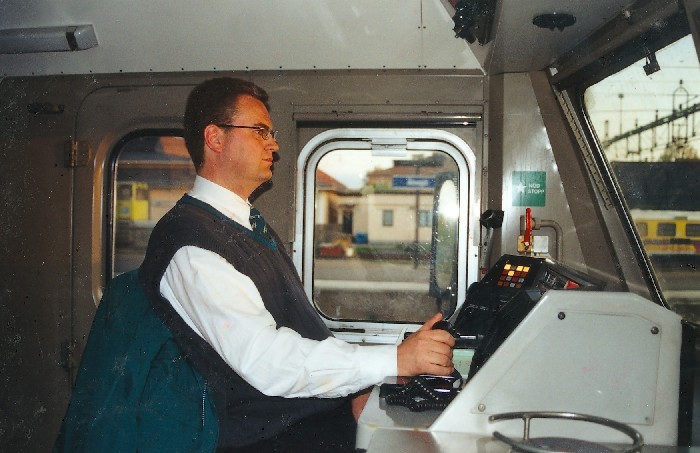
Me in the driver's cabin in the EMU X10 3133, during my training, in
the early morning on 16 May 2001.
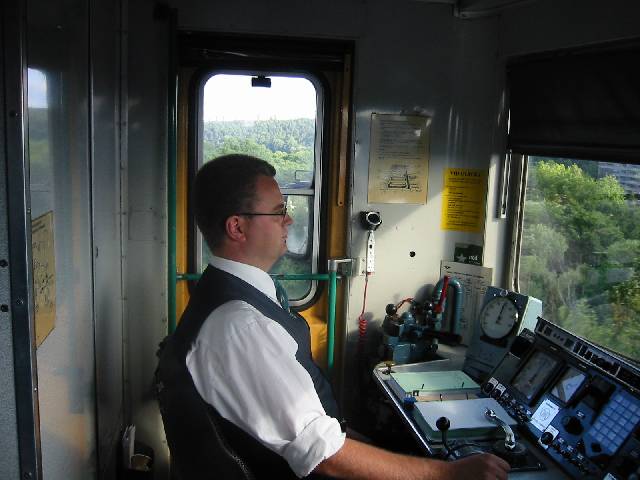
Here, I'm driving an X1 EMU over the Årsta bridge, on 7 August 2001. Photo: © Björn Allerstam.
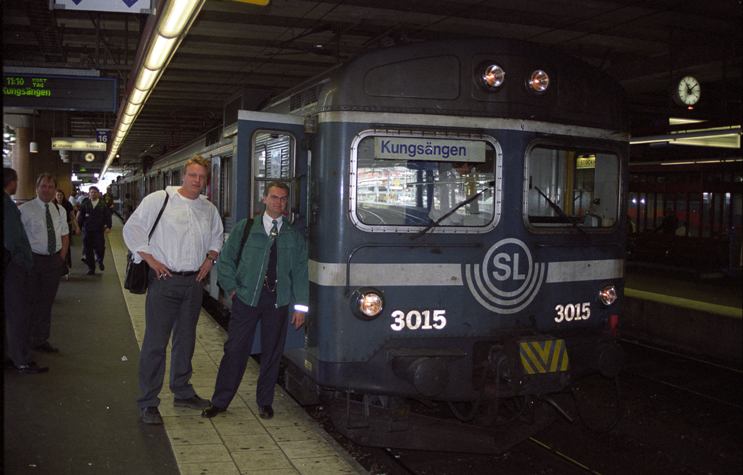
Train driver exam managed! Here I’ve just arrived at Stockholm C with a Nynäshamn to Bålsta commuter train
service on 9 August 2001. One of my fellow class mates is about to release
me. The EMU X1 3015 was used in the first tilting train test runs in the early
1970’s. That project later lead to the X2(000) tilting train. During these test
runs, the EMU X1 3015 was fitted to be able to run at 200 km/h and reached the
top speed 222 km/h between Moholm and Töreboda on the Western main line, the World record for
the X1 EMUs… Later on, the X1-A (Driving Motor Second) and the X1-B (Driving
Trailer Second) were exchanged with the EMU 3042, so that the 3015 consisted of
3015A + 3042 B and vice versa for 3042! The EMU 3042 was scrapped in April 2007
and 3015 in November the same year.
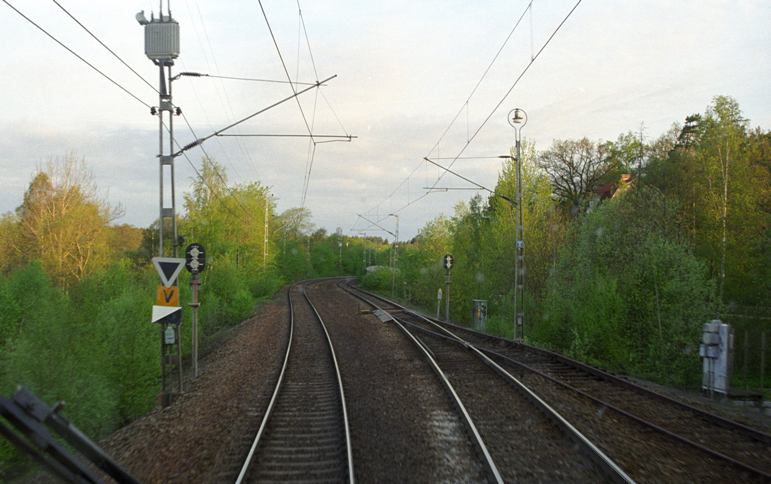
The meeting (passing) station Stäket, seen from the
driver’s cab on 16 May 2001. During my training, I had the possibility to
drive on the old line beteween Kallhäll and Kungsängen, before the new double track line was inaugurated. There were
plenty of unsecured level crossings, therefore we had to signal with the
horn quite often. You can see one of those signs to the left. ‘V’ stands
(here) for ‘väg’, which means road or way in Swedish.
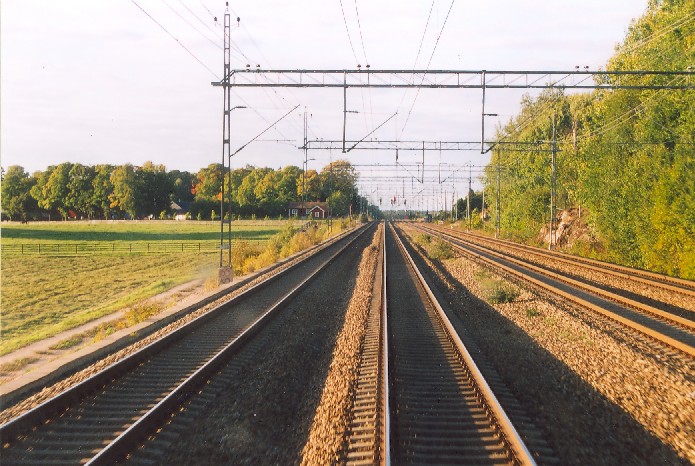
The view from the driver’s seat. The 4-track East Coast Main Line (Ostkustbanan) at Antuna,
between Rotebro and Upplands Väsby, on 25 September 2001.

Western Main Line (Västra stambanan) between Tumba and the former station Uttran.
The signal with three yellow lights is called ‘Scull’ and is a level crossing
distant signal.
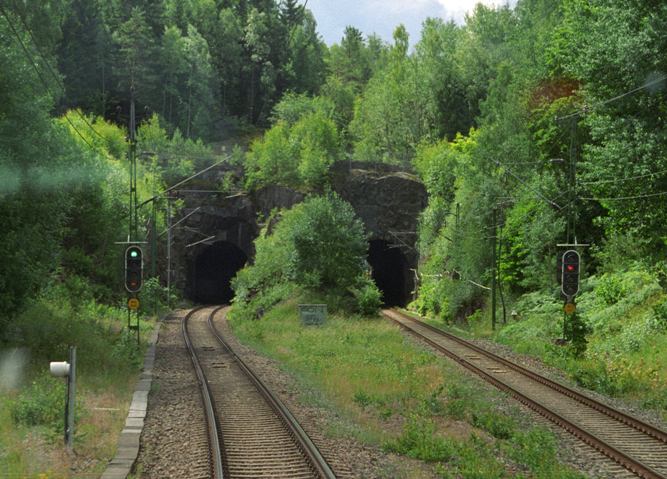
The tunnels at Bränninge, between Södertälje and Järna on the Western Main Line, on 28 June 2002.
The right tunnel is one of Sweden’s oldest railway tunnels, which are still in use – it was
finished in 1861. This route is normally used only by SL’s commuter trains an
freight trains, though it happens (e.g. by traffic disturbances) that long
distant and regional trains are being redirected from the Grödinge
route to this route.
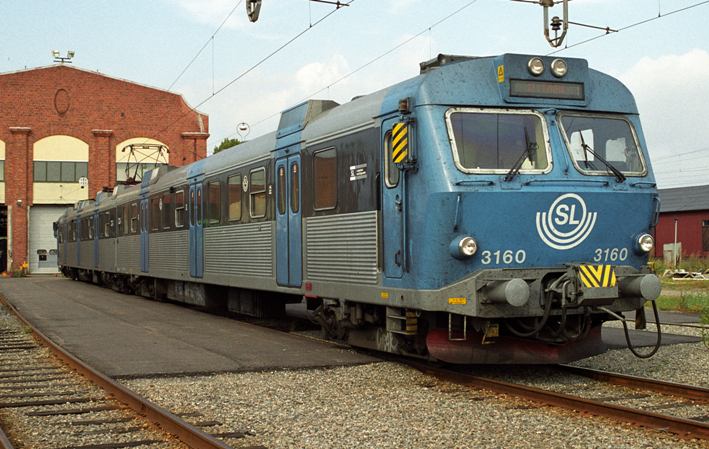
X10 3160 at Tillberga Works on 6 September 2002.
During my time as a train driver at Citypendeln, I
gained route training for the routes to workshops outside the ’normal’ commuter
train area. SL and Citypendeln contracted workshops
in Motala and Tillberga.
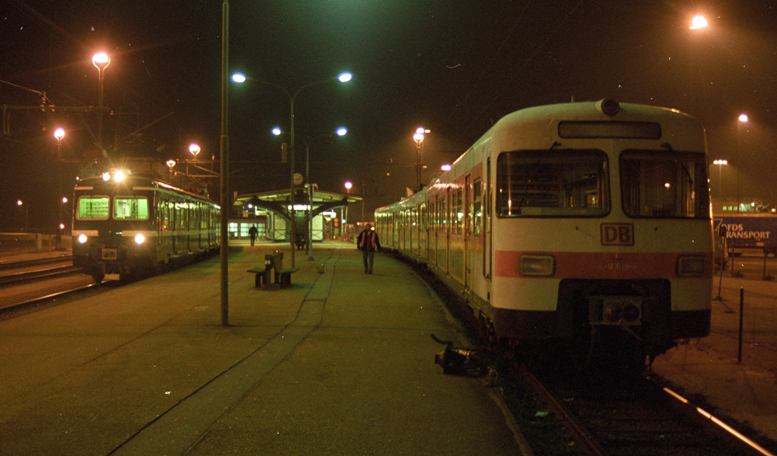
Early morning pick-up at the Trelleborg ferry terminal, on 7 November 2002.
To the left the X420 062 and to the right 420 119. The latter had
just before been pulled of the train ferry from Germany. Both EMUs were coupled
together and driven up to Motala in multiple mode.
I participated formerly as an interpretator, but I also drowe the train from Nässjö down to Trelleborg, and from Stockaryd up to Motala.
After this trip, including a standstill in Norrköping with technical support from Germany, I thought, and many with me, that I'd get the X420 training immediately, which wasn't the case.
I was planned for it in September 2003, but then I was on parental leave.
Then it wasn't possible until Januay 2004... I switched over to DB Regio in December 2003 and got the X420 training and licence immediately.
Sad to say, I got a feeling, it wasn't really a good thing to show (positive) interest in the 'German trains'
Neither Citypendeln, nor the Unions, were amused by those old and used, but convenient, commuter trains.
That DB walked through the 'back door' into the 'back yard' of Citypendeln's french owner Keolis wasn't very well recieved in Paris.
This influenced the X420-service and project in a negative way through the whole time.
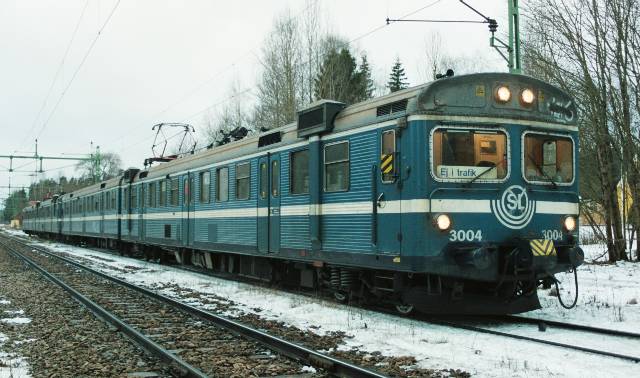
Awaiting a passing train, X1 3004 stands in Åsbro, between Motala and Hallsberg, on 15 January 2003.
A nice trip for me, that then, more or less, only drove trains in the SL commuter trains area.
In the beginning of February 2003, the winter kept Stockholm and its surroundings in a cold and snowy grip.
The Railway had a lot of difficulties due to the rough conditions. In the early morning on 5 February 2003,
I drove the 2580/2689 rush hour extra service from Tumba to Jakobsberg and back.
I was about 5 minutes delayed on the way up, due to door problems, but more than half an hour late on the way back, due to point problems (out of control) at Jakobsberg.
Here the trains stands in the parking siding at Tumba after the arrival.
Early morning in the Älvsjö depot yard, on 2 June 2003.
The trains are being prepared for
the demanding rush hour services. X1 3102 was the last railway vehicle that was
manufactured at the ASJ plant in Linköping.
The EMU was taken out of service in October 2007, but was later put into
service again. Though in the beginning of January 2008, it was ‘doomed’ and was
driven to the Nykroppa scrap yard.
DB Regio
Here, I’m driving one of the X420 trains on its way
to the Nykroppa scrap yard. I am, of course, wearing
the DB train driver leather jacket! Photo: © Jonn Persson.
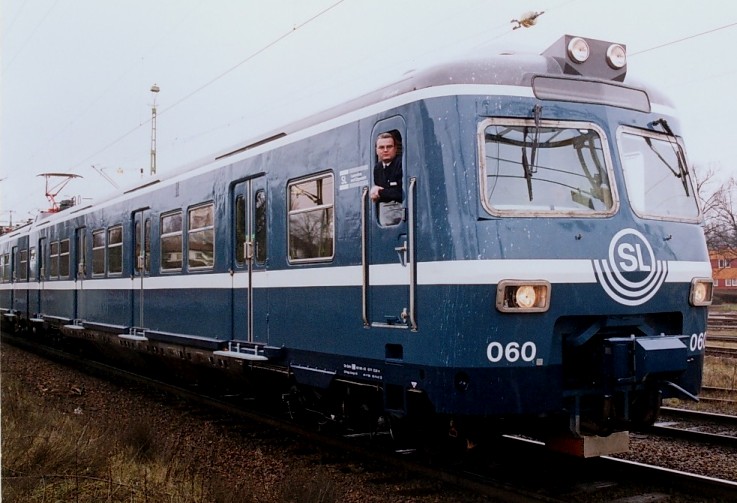
On the 11 December 2003, I’m posing in the drivers cabin window in Hallsberg,
on our way ’home’ to Älvsjö from the Motala workshop.
During one week in September 2005 and one week in May 2006, I participated in
the course ‘Investigating Accidents in Rail Traffic’, arranged by the Railway Train
Center in Ängelholm,
together with the Swedish
Rail Agency. Here I’m standing (to
the left) together with the rest of the Blue Group, in front of the ‘accident
site’, in Helsingborg-Ättekulla, on 17 May 2006.
The group contained representatives and competence from DB Regio,
Banverket,
Euromaint, DSB S-tog and the Metro in Copenhagen.
In July 2005, I had the possibility to drive an ET 420 EMU in Stuttgart!
I was qualified on the X420 in Sweden, but as this EMU actually is German, my qualification was also valid in Germany!
A German trainer was of course present, as I’m neither trained on the German
safety regulations, nor have I gained the line knowledge there before.
SJ AB
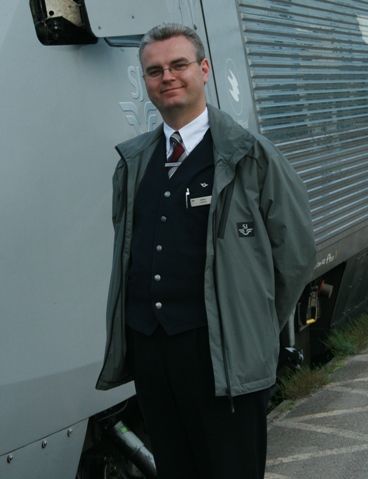
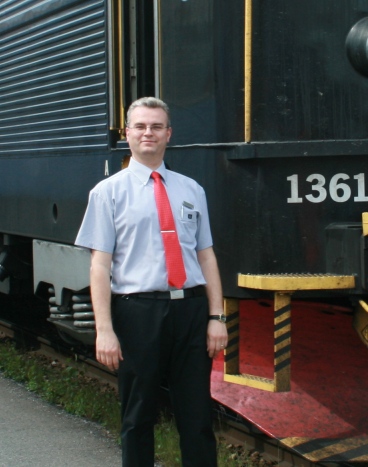
Goodbye, old uniform, and welcome to the new one! 26 May 2008 was the last day,
when we carried SJ's 1997 style uniform. On the day
after, around 3,000 SJ employees changed their
uniform clothing. I was asked if I’d like to be a model for the press
pictures, and I accepted. After all, some of the pictures are OK… Have a
look yourself! On the picture to the right, I wear the new more casual train
driver uniform. It contains chinos, jacket, button-down shirts and/or tennis
shirts. The tie is optional when you wear the shirt. We train drivers have also
the opportunity to choose the ‘normal’ suit uniform, the same that the on board
and station staff is wearing. According to me, that one is very smart, but not
really suitable for the kind of work we do and the environment that we are
working in.
Me in the driver’s cab on the X2000 high speed train.
The driver’s cabin in an Rc6 electrical locomotive.
Three pictures from the traction compartment on the Rc6 1340. On the picture left, one sees the motor switch for motor 3 and the ventilation shaft for the samre motor.
Beyond that, one can see main air compressor the door to driver's cab B.
On the picture in the middle, one sees the cubicle S7 to the left, with automatic switches, and motor switches for the auxiliary machinery.
Besides cubicle S7, one sees the upstart panel with some switches (Test switch, battery, ATC, auxiliary converter etc.) and above the air valves for the pantograhps.
To the left of the door to driver's cab A one sees the motor switch to motor 1.
On the picture to the right, finally, one sees the pressurised air cubicle with different valves and controls, brake systme equipment etc.
The door leads to driver's cab B.
The Driver’s cab in the Rc3 1045 electrical locomotive.
I drove the Rc3 1055 on the 28 April 2009, and was helped with the photographing by the self-timer!
The driver’s cab on a Regina EMU, in this case the DMA
on X52 3276.
Me in the driver's cab in one of the new X55 EMU's, a development from the Regina.
These are fitted with ETCS, and you can see the DMI in the middle.
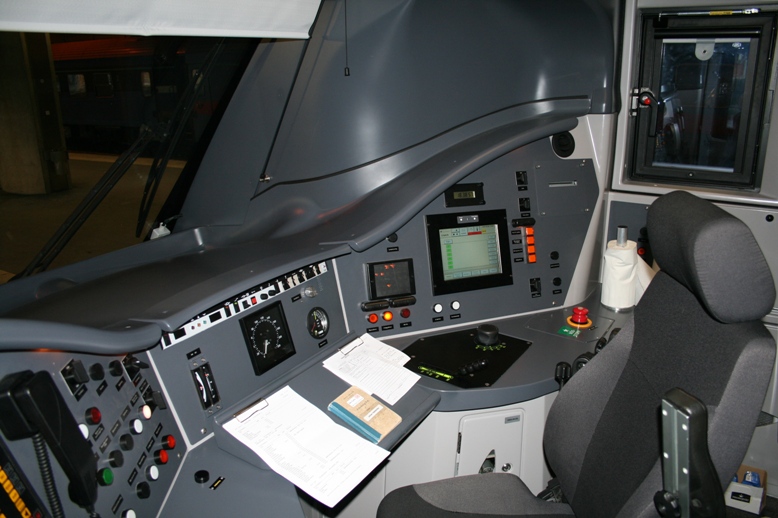
The driver’s cab on an X40 double-decker EMU.
If the driver’s cab in an 'Regina' seems easy to survey and has buttons
and functions quite logically placed, the X40 driver’s cab is quite different.
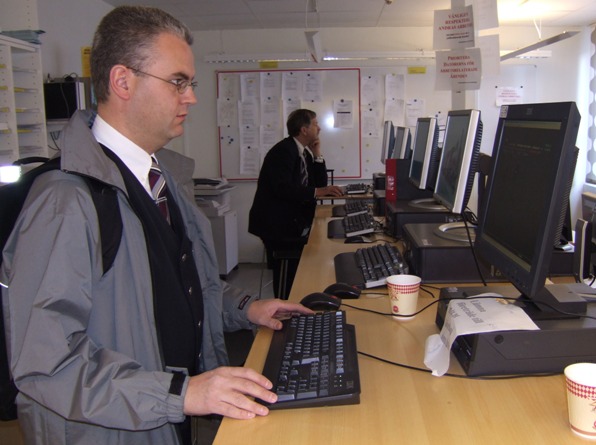
The shift always begins with reading and printing orders, timetable and train
set lists from the computer system. Upon that, we need to bring the route
descriptions, one book for each CTC area (there are
eight CTC centers in Sweden; Malmö, Norrköping, Göteborg, Hallsberg, Stockholm, Gävle, Ånge and Boden). Those books include, apart from the route
description, also information about communication systems, which traction that
is allowed on a specific route and so on. It’s quite a lot of paper that you
need to bring with you… Photo: © Ingemar Lundin.
The train driving duty now and then demands a look backwards through the
mirror.
MTR Express
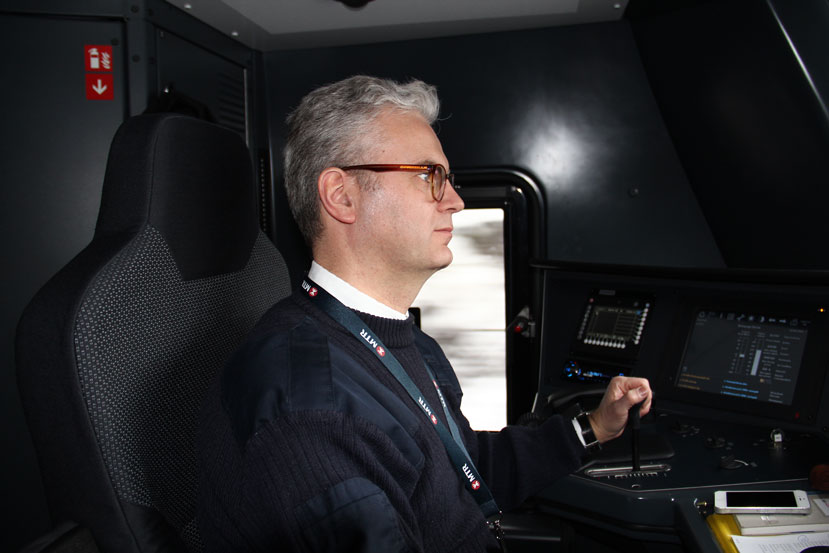
Me driving an X74 EMU.
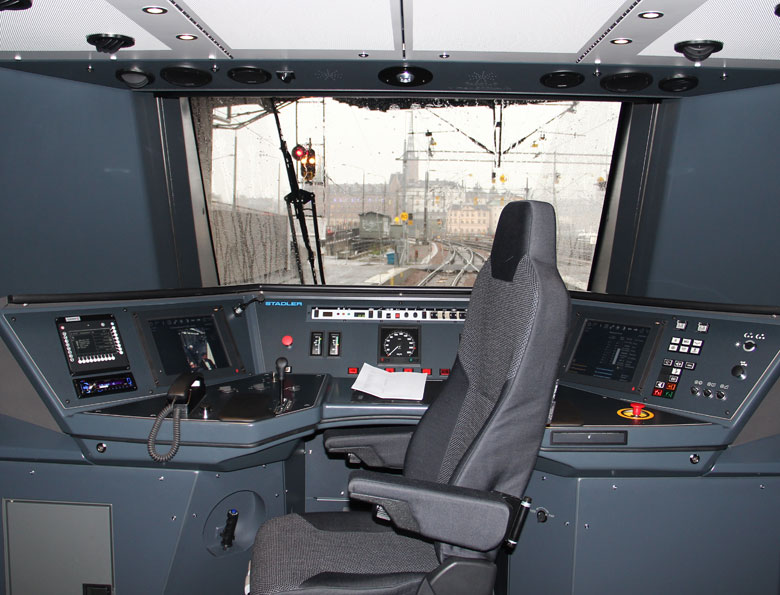
The driver's cab in X74 001.
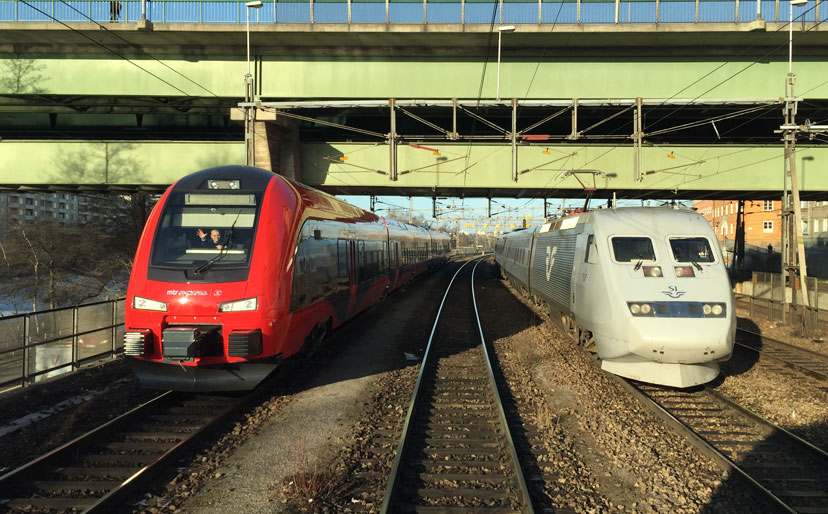
Pictures of trains that I'm driving are rather rare, though it happens sometimes. On the 26 Febrary 2015, I was greeting my photographing colleague on the passing train in Stockholm. Photo: © Björn Mickelsson.
Hector Rail
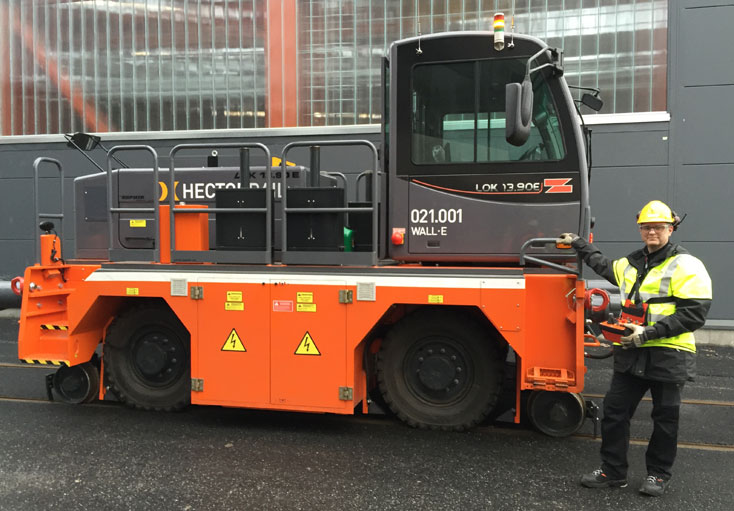
The first loco training I had at Hector Rail was on the "Zephir" Wall-E with Radio Remote Control.
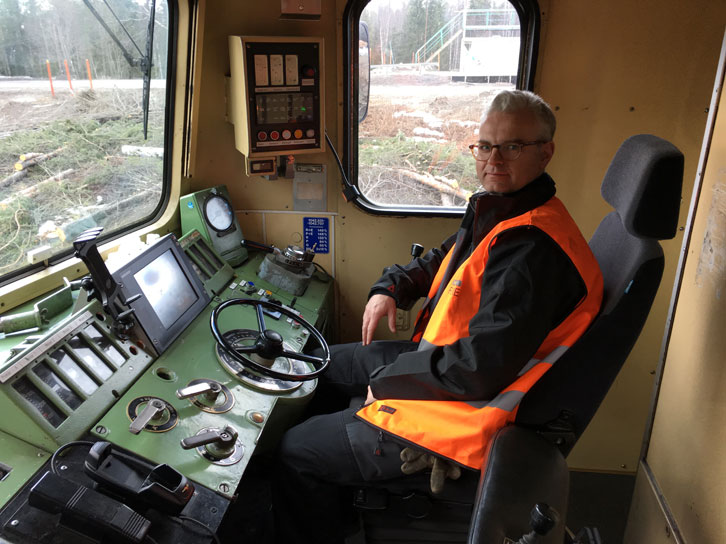
At my visit at the colleagues in Ånge on the 7 April 2016, I was offered to test drive one of the 142.2-locos (former ÖBB Rh 1042)! These locos are equipped with ETCS/STM.
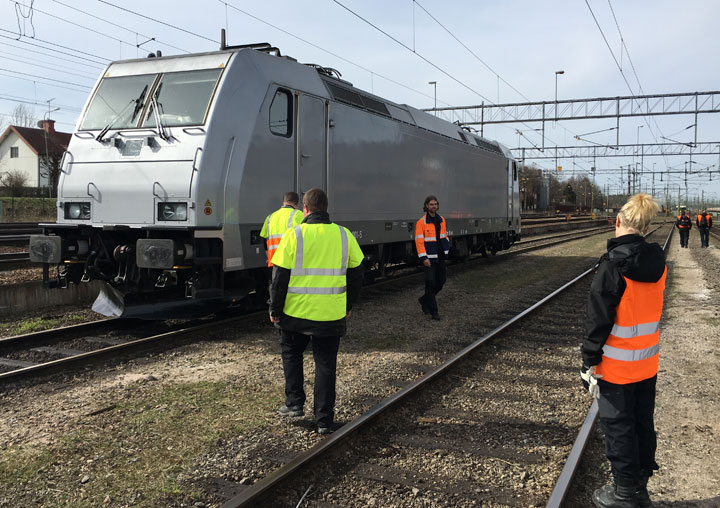
Loco training on the Bombardier Traxx in in Hallsberg on the 13 April 2016. Hector Rails own Traxx-typ is 241, but sometimes extra locos were rented, as this one; the 119 001 from Alpha Trains. It is the former Norwegian CargoNet El.19 119 001, with EVN 91 76 0 119 001-5 N-CN.
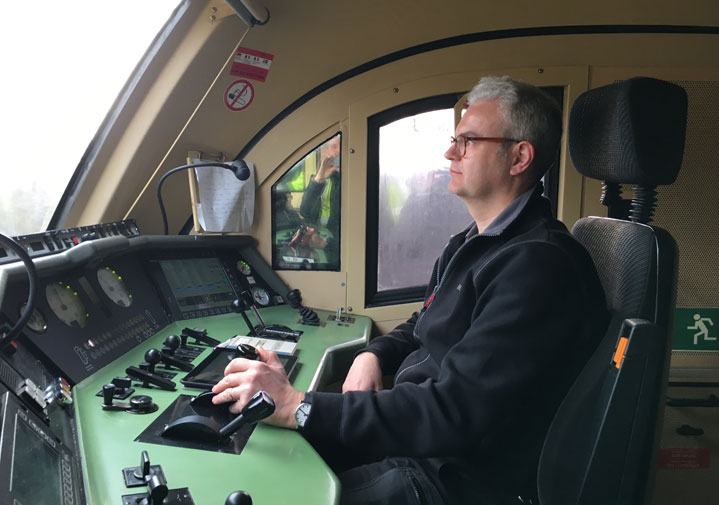
Loco training on the Taurus 242.531 LaMotta.
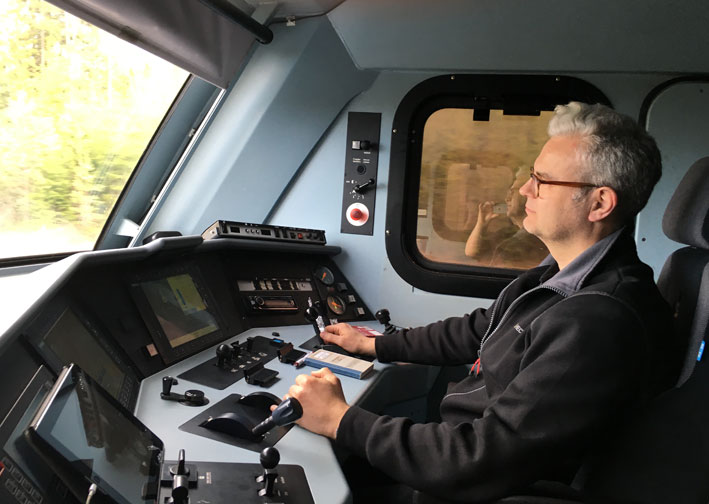
Another loco training, this time on the 441.001 Cyborg (Siemens ES 64 F4 a.k.a. BR 189).
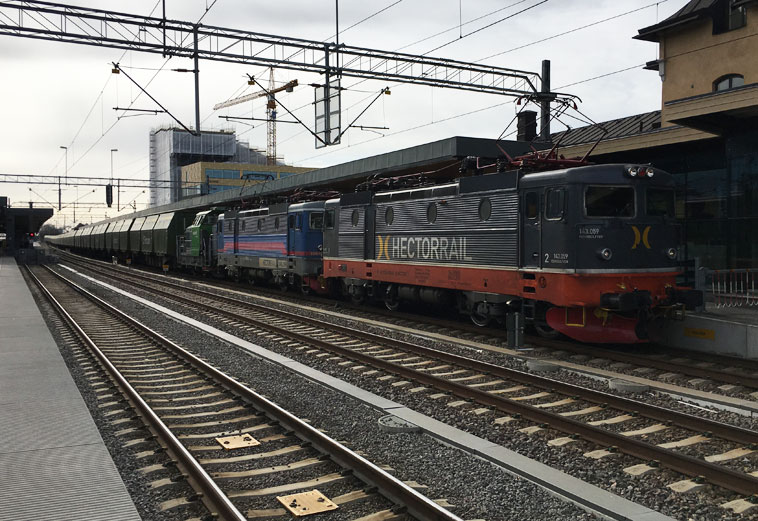
On the 21 April 2016, I drove the train 40110 to Forsbacka (west of Gävle), for biomass (woodchips) loading.
This time, it was an old acquaintance; the former SJ Rc3 (143 at Hector Rail), as well as the new Vossloh diesel G6. I took the picture during a short halt in Uppsala.
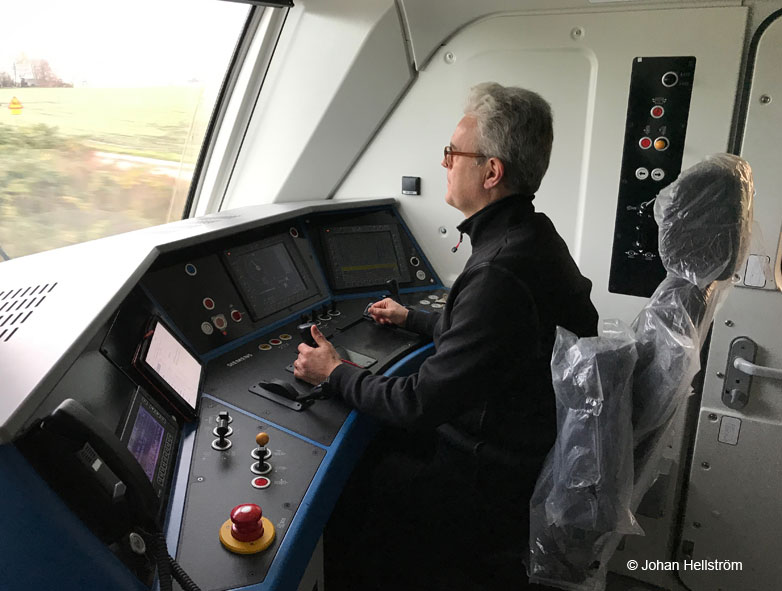
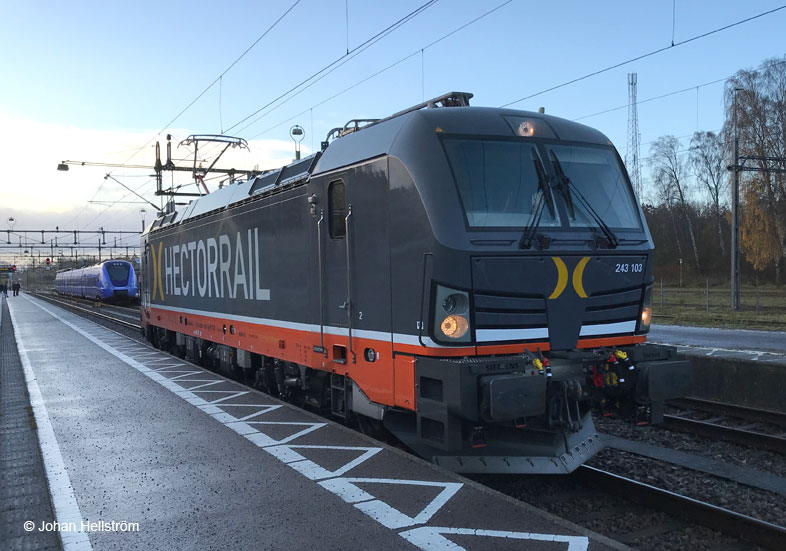
On the 15 November 2017, one of the new Vectron-locos, 243.103 Stephenson, was driven from Malmö via Gothenburg to Hallsberg. As I occational was in the are, I did a short training drive between Åstorp and Ängelholm in the southern part of Sweden.
The Stockholm Area
The locomotive yard at the Hagalund depot.
Here all current four colour schemes on the Rc-locomotives
can be seen; grey, dark blue, SJ-blue and black.
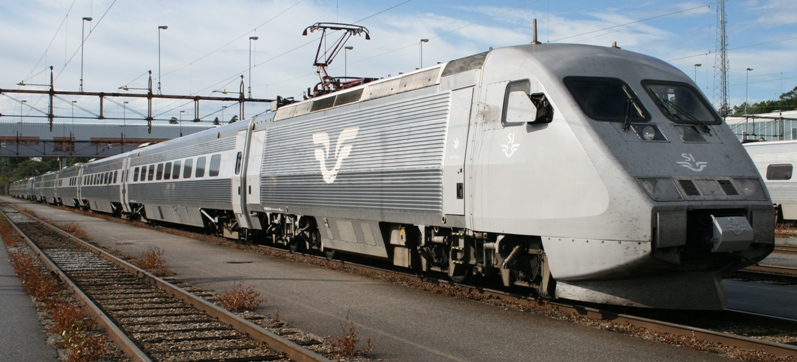
11 August 2008 was the first time, that I prepared and drove an
X2000-trainset in multiple mode. Two X2-trainsets
coupled together gives a length of 279 meters. Please also note the coupling
cover, used since the summer 2007, when the X2000 train sets started to run
regularly as multiple units. Though not very aesthetic, it’s quite functional.
Yet another qualification done, i.e. the driving trailer AFM7.
Here, one of the three DTs, Number 5543, is standing in the depot yard at Hagalund on 26 January 2010.
Training on the X55 EMU in the yard at Hagalund depot on the 27 February 2012.
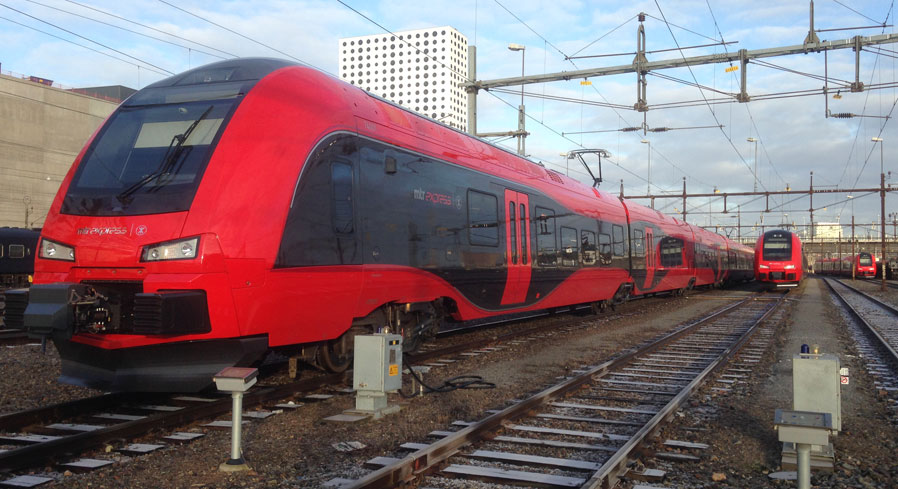
Three MTRX X74 in Hagalund in the morning of the 26 February 2015.
From the left to the right: 74001, 74002 and 74003.
We take a short detour to Sundbyberg, northwest of Stockholm. The railway line is winding through Huvudsta, a part of Solna.
Sundbyberg in the western direction on the 8 March 2010.
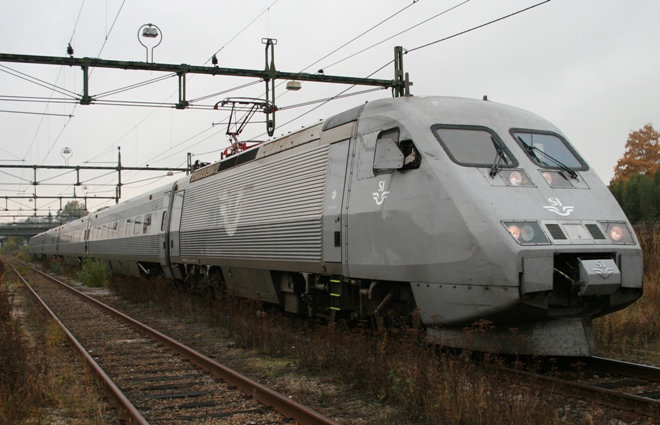
X2 2025 on Stockholm Northern station on the Värtan freight line on 16 October 2007.
Normally, all X2000-units runs with the power unit turned south, but sometimes
it's impossible to drive from that end, and the trainset has to be turned
around. Here, I'm doing exactly that, by using the track triangle via Karlberg – Stockholm N – Tomteboda shunting yard.
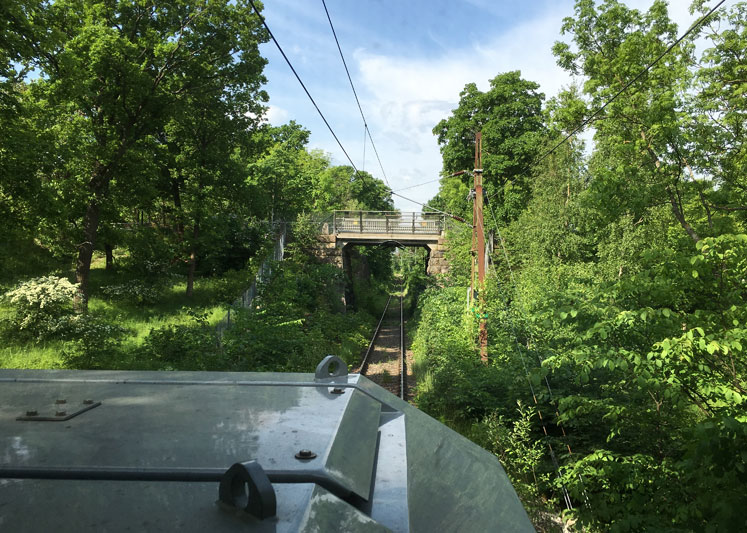
Driving the G6 diesel loco from Värtan to the Hagalund Depot on the 1 June 2016. The Värtan line is situated in the northen part of the city, partly in the wood, and connects the harbour area in Värtan with the main line.
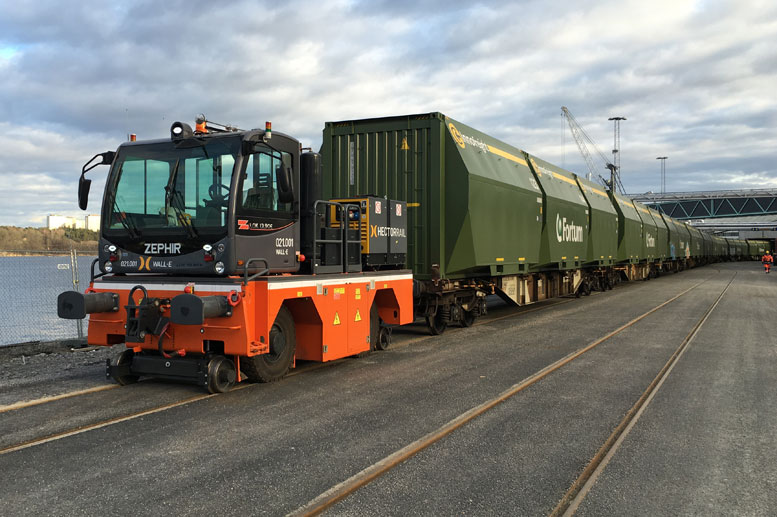
The 021.001 WALL-E in Värtan harbour, on the 17 March 2016.
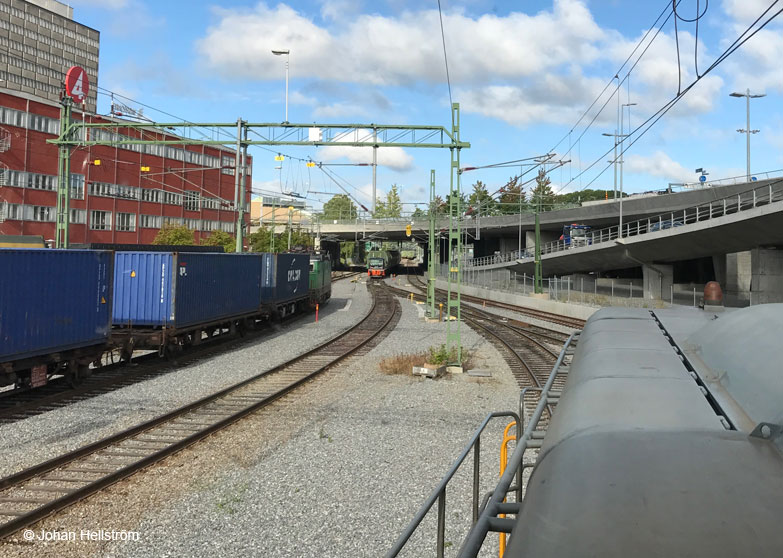
"Full house" in Värtan on the 23 August 2017.
Four trains fron three RU's, and a loco from a fourth RU, on the 14 May 2010, between Stockholm C and Karlberg. From the left to the right: SJ doubledecker X40, the Veolia long distance train (today "Snälltåget"), hauled by a Hector Rail-loco, a Stockholmståg commuter train, and a SJ loco-hauled train.
On 8 December 2006, the X2K 2037 is heading a Stockholm to Copenhagen X2000
service, at the service platform at Norra Bantorget, just north of Stockholm C. The train is to be
fitted with food and beverages etc, before rolling down to the platform for
embankment. Those X2000-trains were rebuilt for the Öresund fixed link to Denmark.
The national railway companies have usually chosen their own solutions on the
same problem. Therefore the safety regulations in Sweden and Denmark diverges,
as well as the signal systems, the ATC-systems and
the electrical systems (15 kV, 16 2/3 Hz in Sweden and 25 kV, 50 Hz in
Denmark).The lovely word interoperability
is at least almost reached with these trains…
Black traction. The locomotives and coaches for the
Rock train special during the summer 2006 were painted in a new black livery.
Later on, the SJ AB board decided to repaint all
locomotives and coaches in this black livery.
On 5 June 2009, the newly renovated Rc6 1352 is ready to depart from Stockholm C with a commuter working to Uppsala.
The loco number is also written according to the new European Vehicle Number (EVN) system; S-SJ 91 74 106 1352-0.
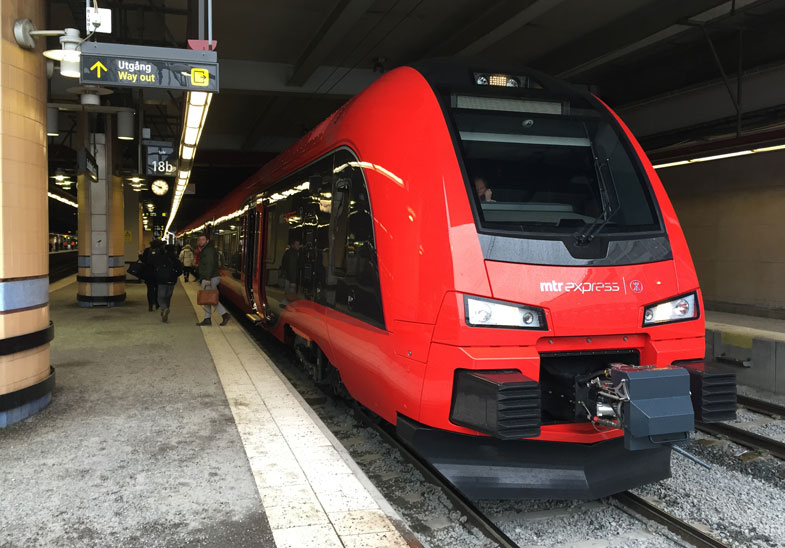
MTRX train 2000 arrives at Stockholm C on the 23 March 2015, the first workday with commercial service. With proud, I released the colleague, and drove the train further on to the Hagalund depot.
Gray trains in a gray station. To the left the X2 2006 heading the X 2000 service 637, which I drove to Karlstad on the 25 January 2011.
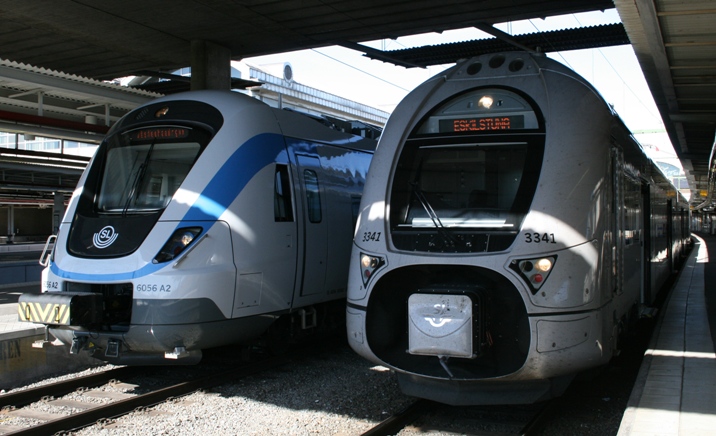
A study of modern train design in Stockholm C on 5
September 2007. To the left the EMU X60 6056, with a Bålsta to Västerhaninge commuter train service and to the right the double-decker EMU
X40 Z1 3341 bound for Eskilstuna. Both EMUs are
built at the Alstom-LHB Salzgitter plant, for use in Sweden, but there ends most of the similarities...
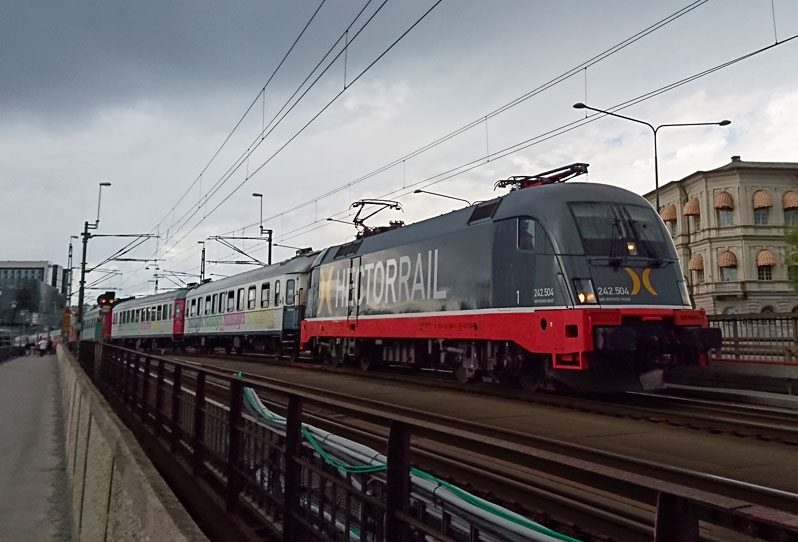
Finalling my first 6 months at Hector Rail, and just before my summer holidays, I drove the "Snälltåget" to Malmö and back on the 9-10 July 2016. My departure from Stockholm was catched by my colleague ET. Photo: © Erik Torstensson.
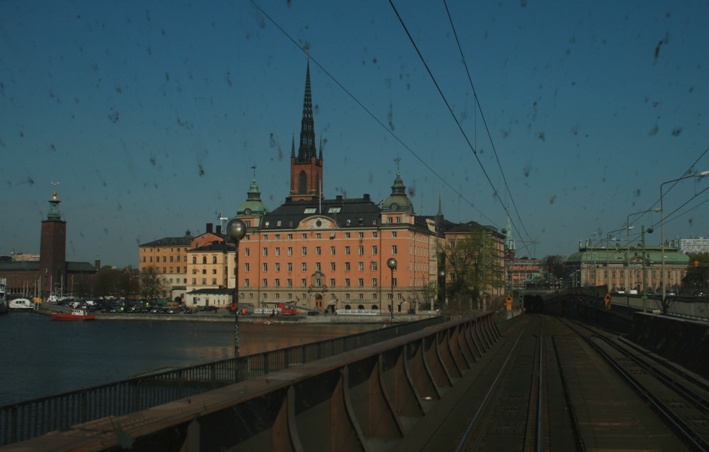
This lovely view meets the train driver as one comes out of the tunnel under Södermalm and rolls out on the bridge toward the Old Town and Stockholm C.
Beautiful sunset over the Årsta bridges on 24 March 2009.
Lake Mälaren Valley
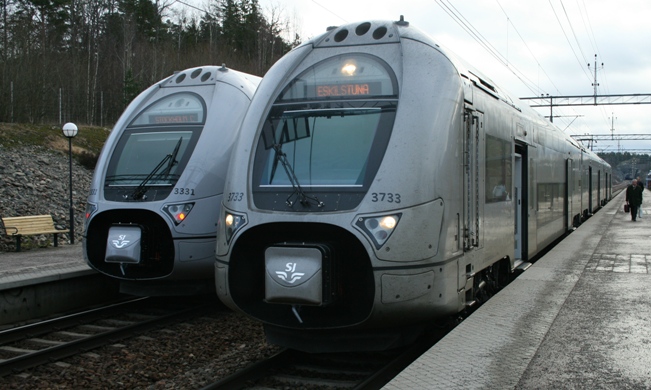
Two X40 double decker EMUs meets at Läggesta (close to Mariefred and the Gripsholm castle) om 13 January 2009.
Misty morning on 13 October 2006 in Härad on the Svealand Line,
between Strängnäs and Eskilstuna.
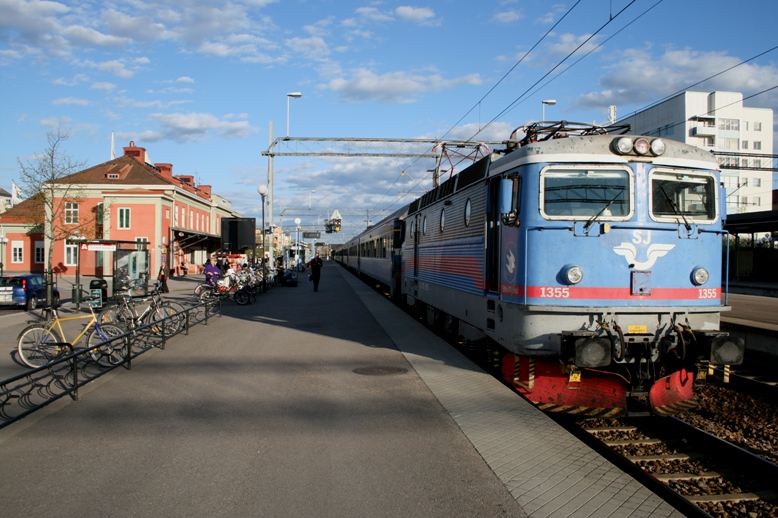
The Stockholm to Eskilstuna regional service number 995 has reached its destination in the evening on 27 April
2007.
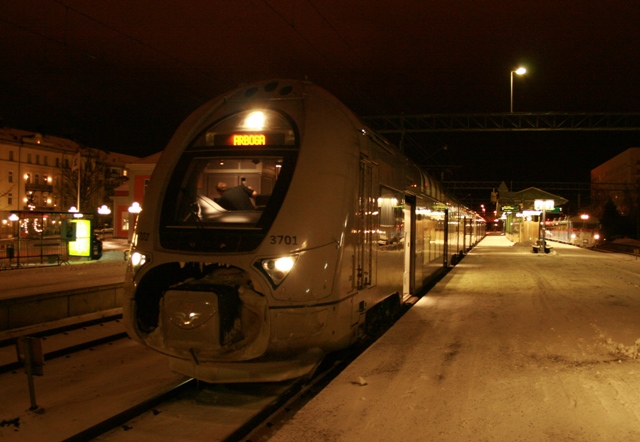
In the morning on 4 January 2008 the EMU X40 Z5 3701 is being prepared for
departure to Arboga from Eskilstuna by a train driver trainee. In the background to the
right, an X12 EMU stands ready for departure to Västerås.
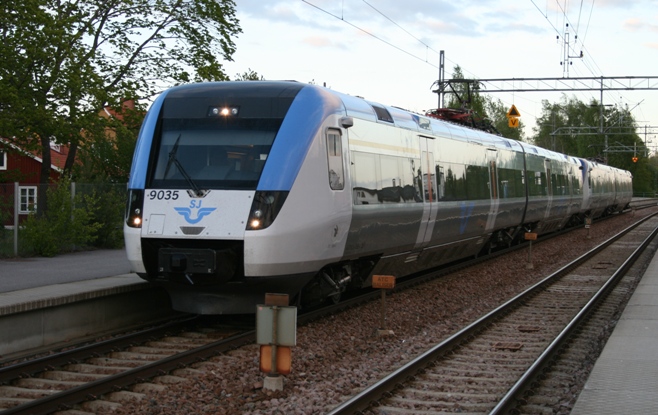
The 'Regina' EMU X52 9035 at Kungsör in the evening on 8 May 2007.
On the Lake Mälaren Line (north of the lake), between Bålsta and Enköping,
one has this beatiful view from the bridge over Ekolsund!
Passing the 'Coop-train', hauled by the Rd2 1092, in Grillby on the 29 June 2012.
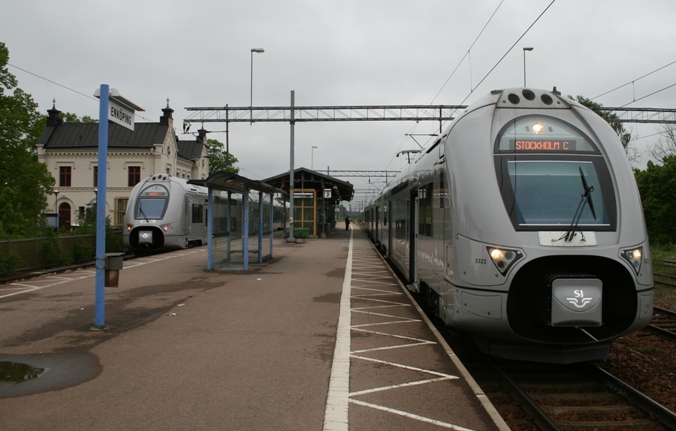
Two X40 EMU's passing at Enköping on the 22 May 2007.
To the right 'my' regional Västerås to Stockholm C service 703.
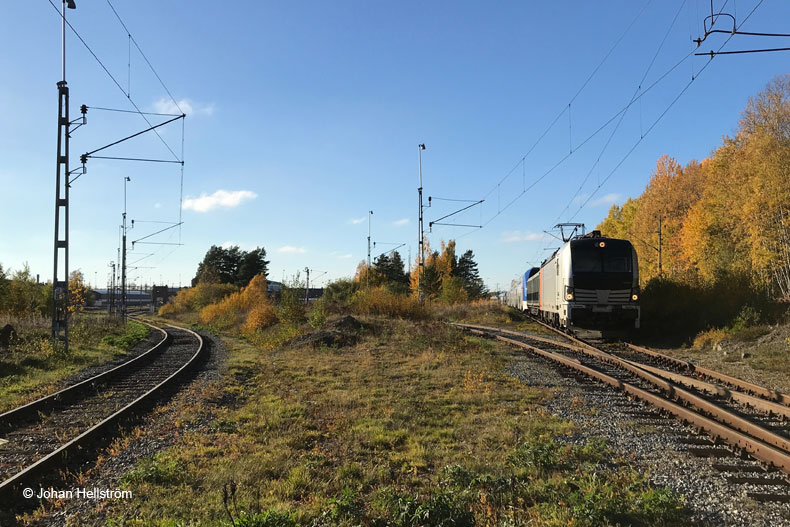
Arrival in Tillberga with another ER1 delivery on the 11 October 2018.
On the 29 June 2012, I drove the new, not yet delivered X55 EMU 3355 from the Bombardier plant in Västerås to the depot in Hagalund.
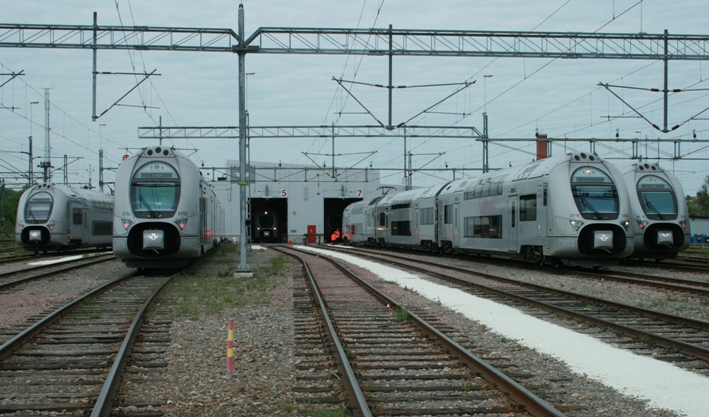
An X40-EMU line-up at the Västerås västra (west) workshop, on 26 May 2008.
These EMUs have already gained lots of (nick-) names; The Berlin Wall (it’s grey and doesn’t
move), Concrete high building, “Trouble-Decker” etc, due to the rather
difficult introduction of the EMUs. Today, they behave quite well. One thing
is for sure: One shall never underestimate the cultural differences and (maybe)
barriers that exist in the railway industry. This EMU is developed in France,
but manufactured in Germany for service in Sweden. Three countries with proud
railway traditions, and hence different ways of defining problems and solutions…
Originally all 42 units were supposed to be delivered in 2005, but it took further four years before it was possible.
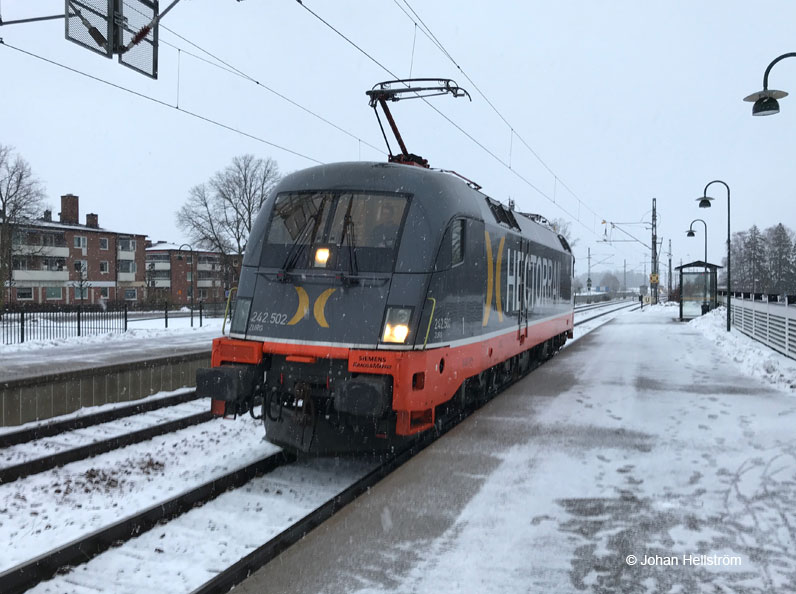
On the 31 January 2018, we performed a ETCS/STM test run with the "Taurus" 242.502 Zurg. At Kolbäck, we changed direction and continued to Hallsberg.
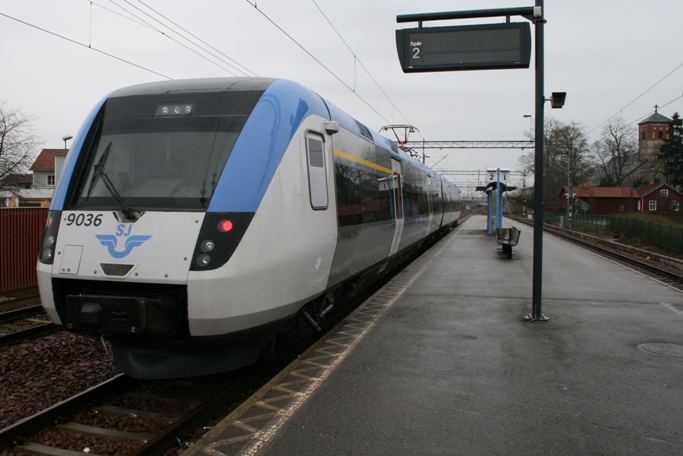
The Regina-EMU X52 in Arboga on 23 April 2007.
The Regina is very easy to drive, which is good and bad. This picture is
historical, as the Regina-EMU’s now-a-days are put into service elsewhere in
Sweden, and are replaced with X40-EMU’s in Lake Mälaren
Valley.
Schienenfahrzeuge aus Salzgitter.
The double-decked EMU X40 Z5 3711 on Örebro C on the
1 February 2007.
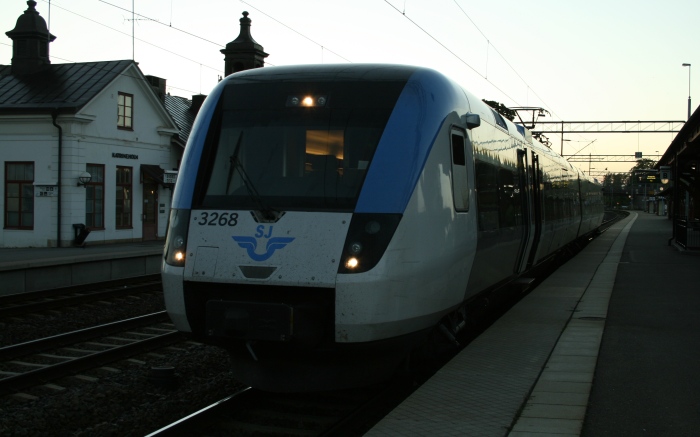
One of the few 'Regina' diagrams I had on my working schedule during the fall 2007 was a short but nice
one. I prepared a unit at the Hagalund depot, and
drove it as an empty run to Katrineholm. From there,
it went as the Katrineholm to Hallsberg
regional working 601. In Hallsberg, I put the EMU on a siding and travelled
back to Stockholm as passenger. Since the January 2008, this working is
diagrammed with an X40 EMU.
Northbound
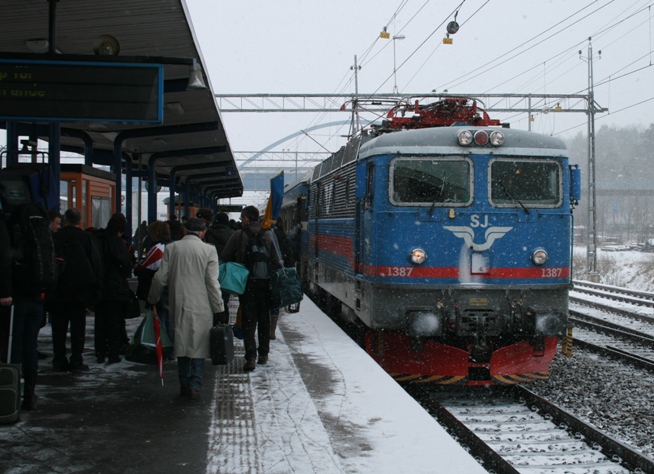
During the Easter holiday 2008, the infrastructure manager Banverket
made large resignalling works at Karlberg, just north of Stockholm C. SJ’s northbound long
distant trains departured from Upplands Väsby station, normally only serviced by commuter
trains. The passengers had to go by bus from Stockholm city. Here, you see IC
16 to Falun being embanked by frozen passengers on
Boxing Day. We were about 20 minutes delayed from Hagalund depot, due to that too many trains had to use a very few points, and almost at
the same time… The weather changed all the time; the sun was shining north of Arlanda Airport, some kilometres away!
Track congestion. The train route is locked for the 'Upptåget'
local service a few seconds before my Uppsala commuter train. Therefore, I had
to wait at Skavstaby junction, where the Arlanda Airport Line connects to the Northern Main Line.
The 'Upptåget' is about to cross over to the second
left track, and I am going to use the track on my left hand. Usually, the Uppsala commuter train
arrives at this site before the 'Upptåget', but a
small delay changes everything. We are many train operators and 'products',
that have to use the same tracks, thus is good planning and dispatching very
important.
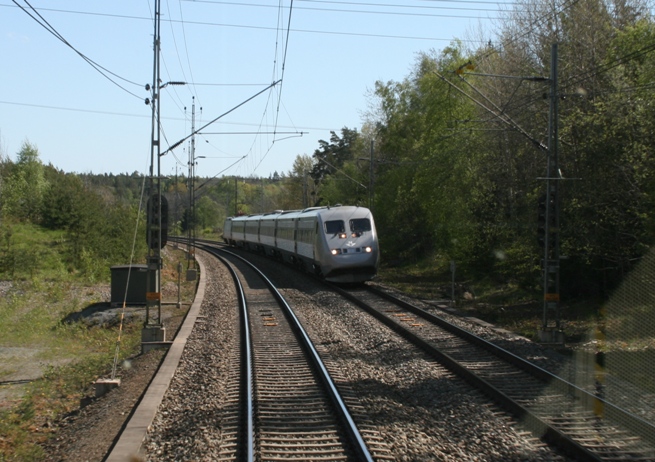
On 15 May 2007, the 'Uppsalapendeln' I’m driving
meets a Stockholm to Sundsvall X2000 service at Myrbacken, between Knivsta and Märsta on the Northern Main Line.
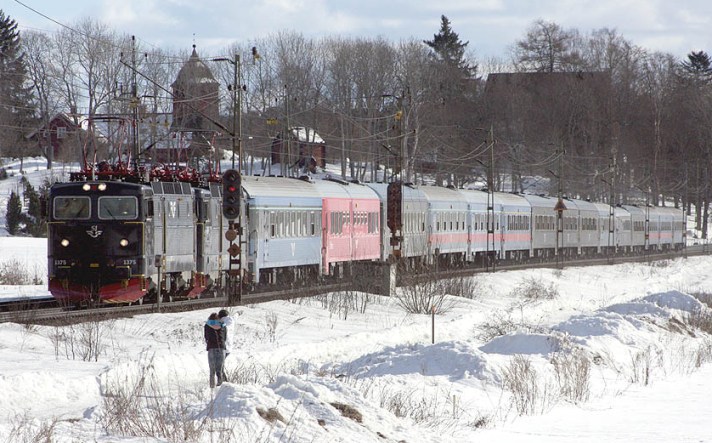
Pictures of trains that I'm driving are rather rare, though it happens sometimes.
On 13 March 2010, I drove the Stockholm to Duved Intercity service 84, seen here passing Knivsta.
Photo: © Jonas Strömblad.
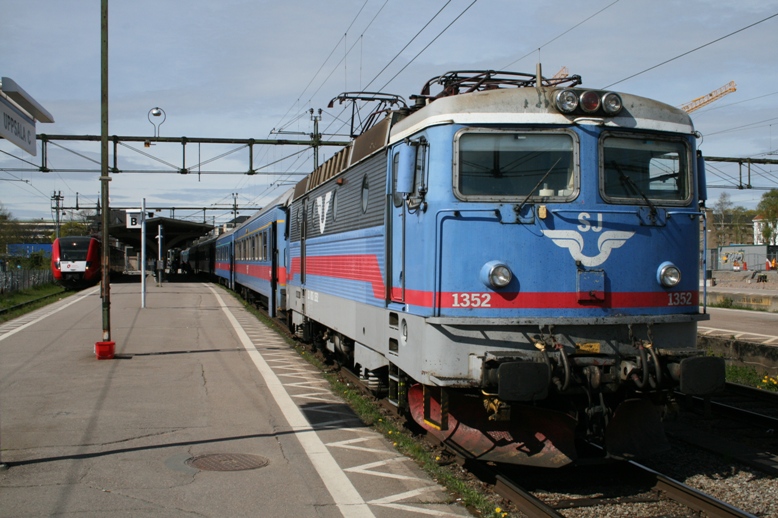
Rc6 1352 heading an Uppsala to Stockholm commuter working ('Uppsalapendeln')
on track 1 in Uppsala.
At the rear of the train is another Rc6 locomotive, controlled from the heading
one, so called SMS-control (in Germany: ZWS).
To the left on track 0 (!) the Regina-EMU X50 9055 is ready for departure as an
'Upptåget' Uppsala to Upplands Väsby via Arlanda Airport local service.
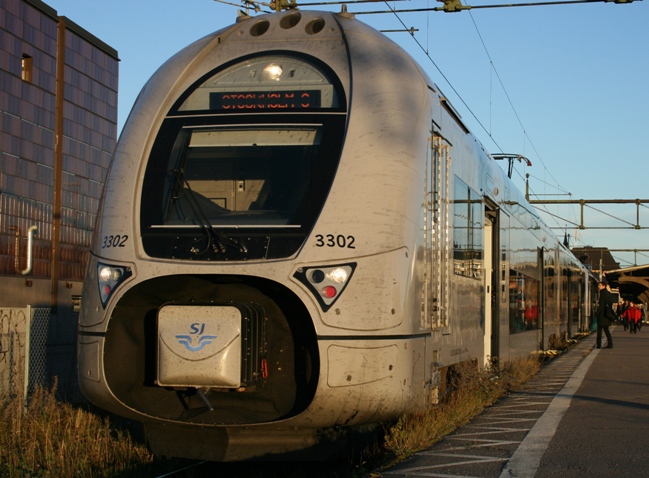
X40 3302 + 3337 ready to depart from track 0 (!) on Uppsala C on 9 October
2007. This is the non-stop Uppsala to Stockholm regional working 887, departing Uppsala at 08:00 o'clock,
and arriving in Stockholm 35 minutes later. This service is very popular and the train is usually more
than full.
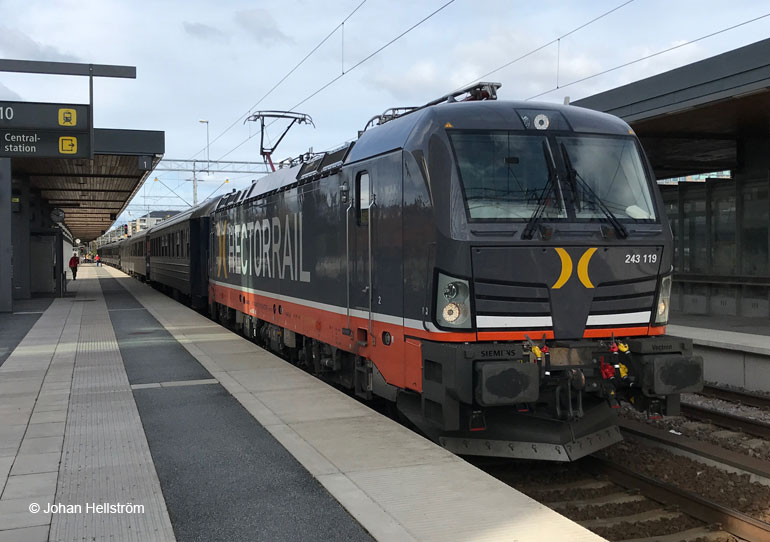
On the 24 September 2018, I drove the "Blå Tåget" ("Blue Train") from Hallsberg to Uppsala and back. Here, the train 7071 is ready for the departure back to Gothenburg.
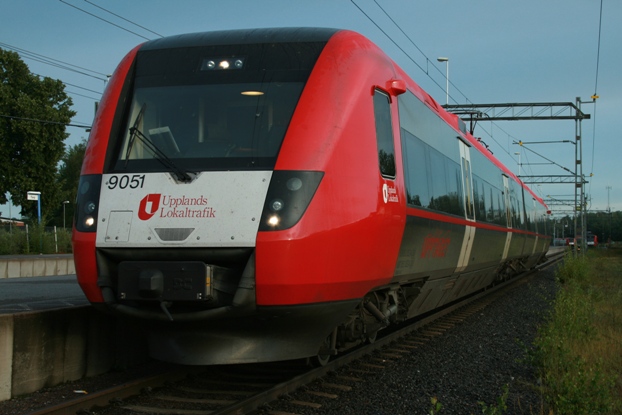
The ’Regina’ EMU X52 9051 used in the ’Upptåget’ regional
commuter services is prepared and ready for service in Tierp in the early morning on 10 August 2008.
Today, the SJ train drivers based in Stockholm only occasionally drives the ‘Regina’
EMUs. But at the end of 2010, we well drive the new Intercity-Regina EMUs. They will replace some X2000 and loco-hauled services, e.g.
for Jämtland and Dalarna counties.
The (Swedish!) East Coast Main Line at kilometer 84, between Marma and Älvkarleby, seen from
an X40 driver’s cab.
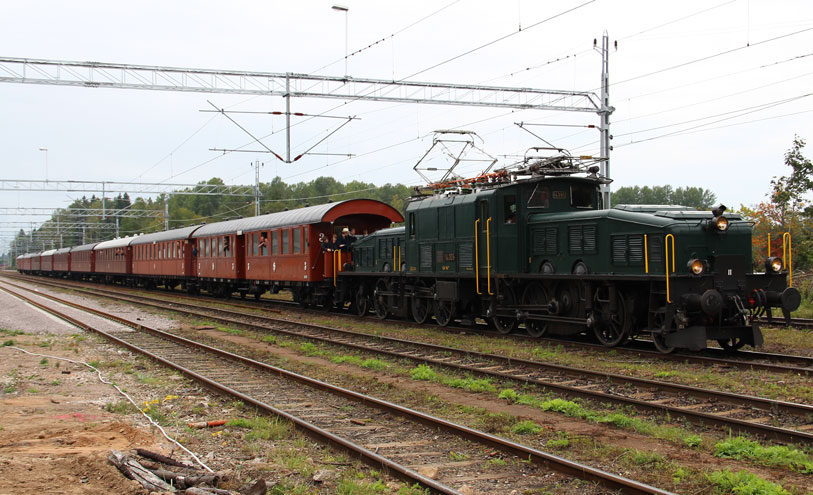
A real special appointment! On the Swiss SBB "Crocodile" Schwedenfahrt on the 12 September 2015, I was piloting the Swiss colleague from Stockholm to Gävle. Here, we're standing in Skutskär, some 10 kilometres south of Gävle, awaiting a passing train.
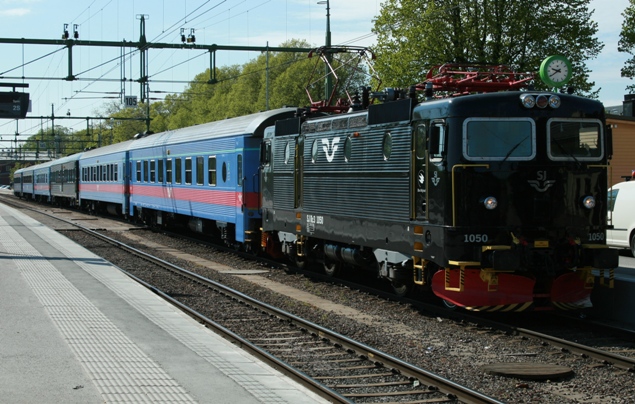
Even the older Rc3-locos were renovated and painted black. The Rc3 1050
hauled the Stockholm to Jämtland county IC woking 80 on 23 May 2008,
and is seen here in Gävle C.
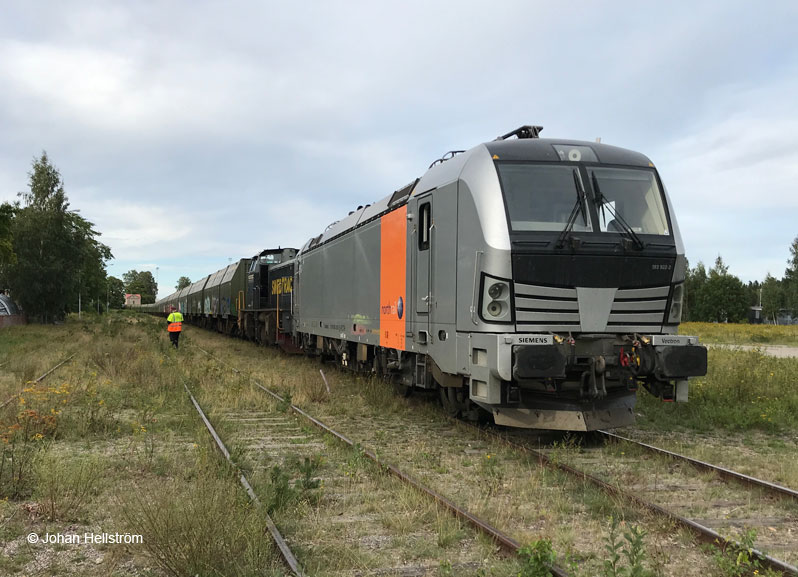
Norrsundet, northeast of Gävle, on the 14 August 2018. We were ready for departure to Bolänge via the main line connection at Hamrångefjärden. The diesel was driven via RRC.
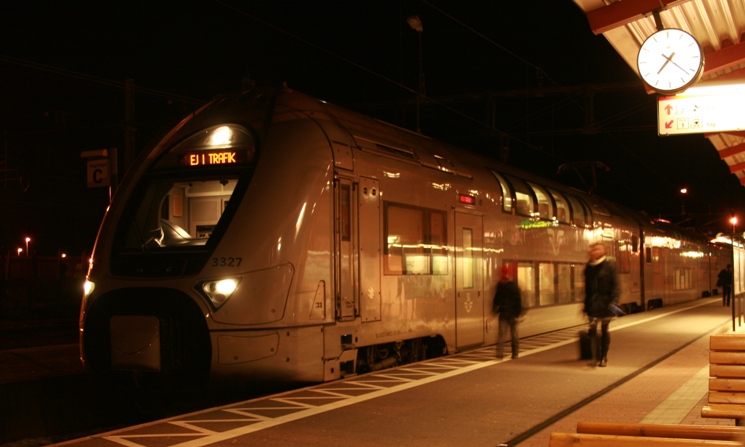
X40 3327 in Sandviken on 13 January 2008.
En route through Ockelbo with the IC 81 on the 22 April 2013. To the left the Rush Rail empty timber train, hauled by the TRAXX-loco 185 410 Bashful.
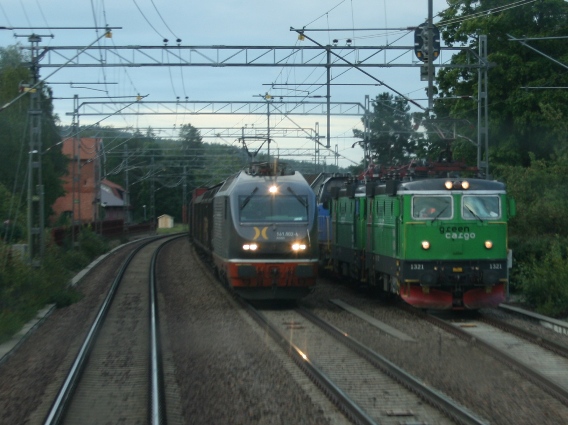
Three trains meeting at Holmsveden on 28 August 2008.
Our southbound Ljusdal to Stockholm regional service 283 meets two freigt trains runned by separate freigt TOCs; Hector Rail and Green Cargo.
The water tower to the left was damaged at a derailment back in 1917.
Still today, one can see the different colour of the old and new brick stones.
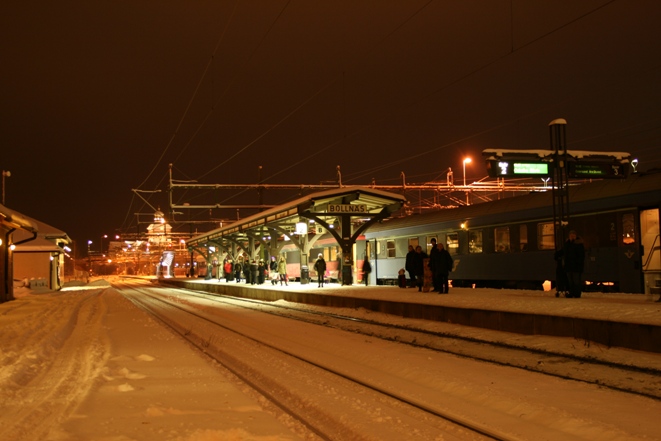
Bollnäs on 14 December 2008.
The Stockholm to Ljusdal regional working 284 stands in Karsjö on 12 May 2009, awaiting the meeting Östersund to Stockholm IC-service 85.
Misty morning in Ljusdal on 10 April 2009.
Between Ramsjö and Ovansjö (south of Ånge), the line has double tracks. Between the passing loop Norrhög and Ramsjö, you have this nice view from the cab whilst driving south.
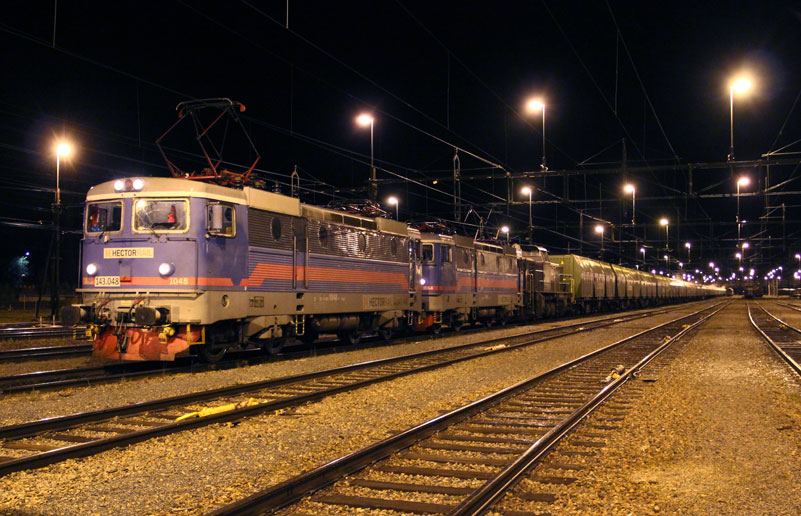
Train 40119 ready for departure from Ånge, shortly before midnight between the 1 and 2 September 2016. It's so far the longest and heaviest train I've driven; 616 metres long and 2344 tons heavy (incl. the locos).
Entering Östersund from the east on the 19 June 2012. The former freight yard was situated to the left.
The Norrala Tunnel between Söderhamn and Hudiksvall on the East Coast Main Line, is one of Swedens's longest tunnels (yet), with its 3,850 Meter length.
On 21 Januar 2010, I'm just about to enter the tunnel from the north.
Sundsvall C in the early morning on 6 September 2006.
X2000 567 Sundsvall to Stockholm working is ready to depart from Sundsvall C in the morning on 21 January 2010.
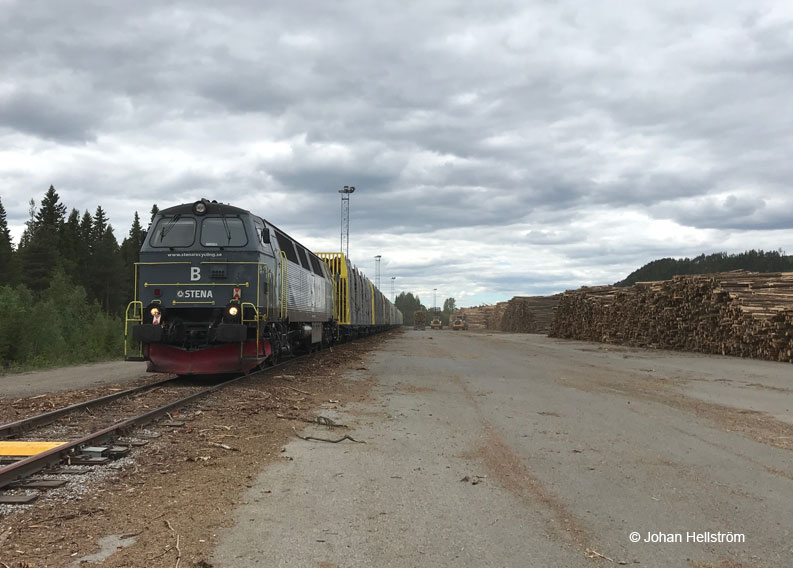
Assessment of timber loading in Hoting, as well as training on the TMZ-loco was on my Agenda on the 4 July 2018.
Meeting with the passing SJ 3000 575 in Hällenyland on the Ådalen line on the 16 August 2013. Between Sundsvall and Umeå, the line is equipped with ERTMS/ETCS Level 2.
A Norrtåg X62 EMU in the passing loop at Stöcke on thre same day.
Nice view over the Ume river from the Botnia line.
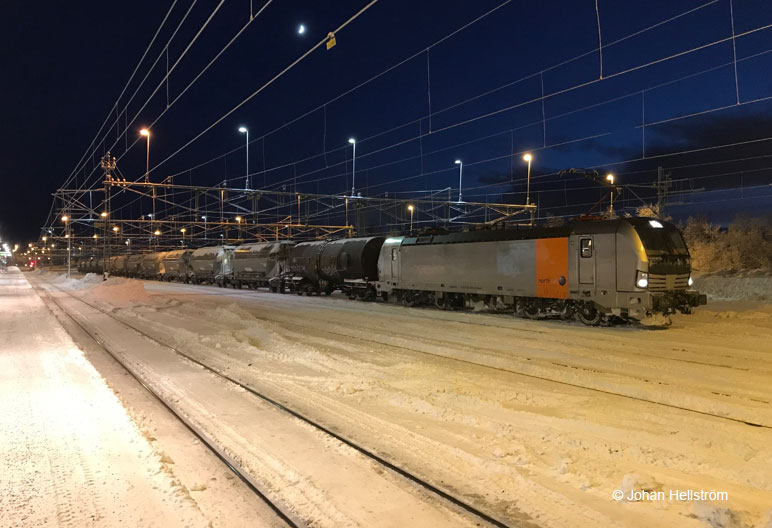
On the 22-23 January 2018, I visited the colleagues in Kiruna and Luleå, and did my own route knowledge training on the train 40501. It was rather "chilly", at -24 °C... Here stands the train, hauled by the rented Vectron loco 193 922, reday for departure in Kiruna.
The Dalarna Line
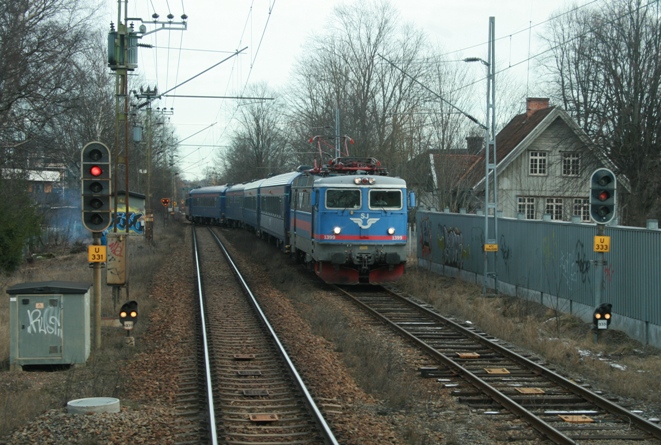
Train passing at Uppsala norra (North) on 5 March 2008. To the
right, one can see the former station building.
During the ‘Regina’ EMU training, we drove the so called 'Uven' (Uppsala–SalaVästerås–Eskilstuna–Norrköping–Linköping regional service).
Here the X52 3260 calls at Sala on 1 March 2007, ready for departure to Uppsala. This unit, as
well as all other Regina-EMUs (apart from those owned by Västtrafik)
is owned by the rolling stock company Transitio, which is owned by most
of the PTA’s in Sweden.
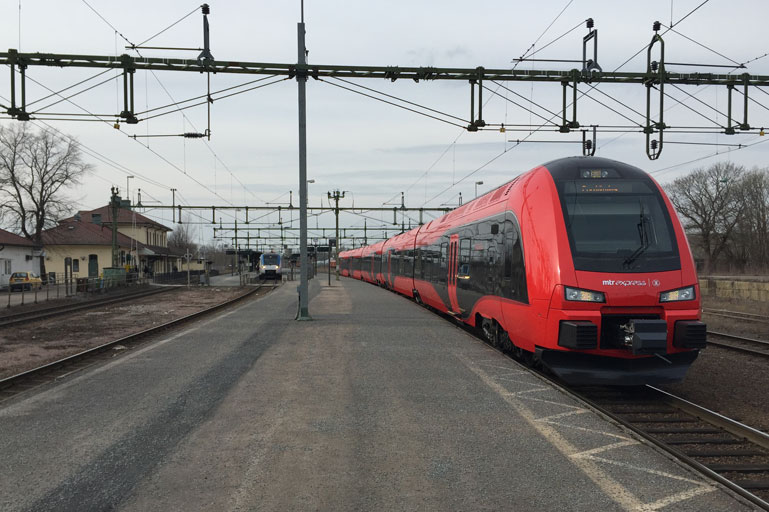
Sala on the 19 March 2015. To the right MTRX X74 002, which I drove on a test run this day.
Sometimes, the signals are at 'Danger'. Here, we have
to wait at the entry signal at Broddbo meeting
station, between Sala and Avesta-Krylbo.
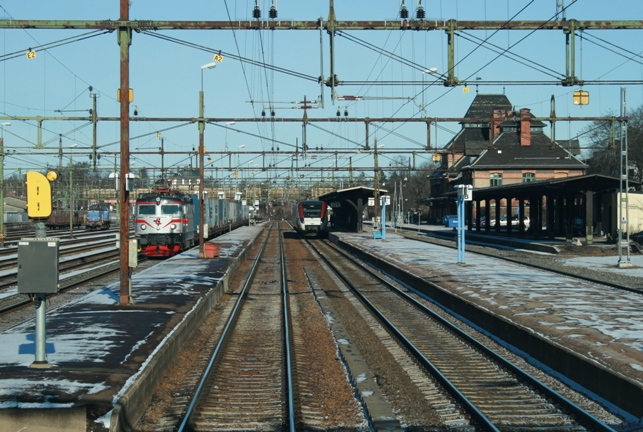
Entering the station Avesta-Krylbo on 5 March 2008.
On the picture, one sees three different TOCs (from left to right Green Cargo, Tågab and Tågkompaniet),
and the picture was taken from a fourth TOC, i.e. the SJ IC-train to Dalarna county.
During the X40-training, we did a special round trip on 29 January 2007 on the route Stockholm - Uppsala - Krylbo - Storvik - Gävle - Stockholm.
In Byvalla, on the former Northern Main Line ('Norra Stambanan'), we made a short photo stop.
Before (i.e. until 1964) the narrow gauge line (891 mm) 'Byvalla-Långshyttans Järnväg' (BLJ) connected here.
This line was special in many senses, but most for running steam engines only until the line closure.
Above that, neither a vaccuum nor a pressurised air brake system was ever installed!
A majority of the rolling stock is preserved at the swedish heritage railways with 891 mm gauge.
Sunset over Borlänge on 6 November 2006, seen from the driver’s cab.
Driving to Dalarna means lots of nice views!
Especially the former private railway BJ, on the line
between Borlänge and Falun. Above the meeting station Ornäs in November 2006
and below the entry to the meeting station Hinsnoret in October 2006.
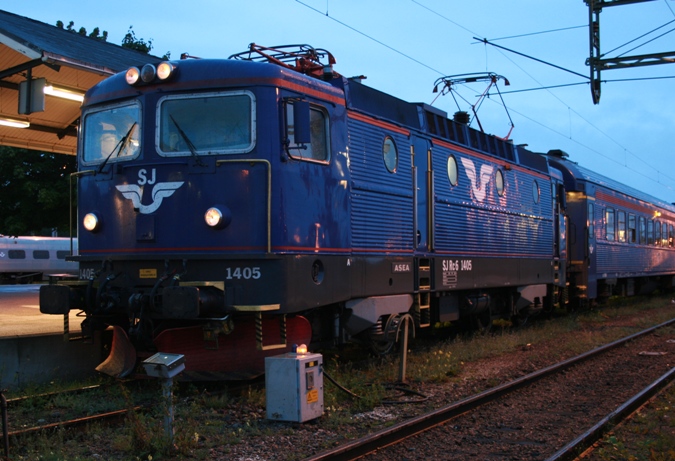
A blue locomotive in the blue hour in Falun, on 13 August 2008.
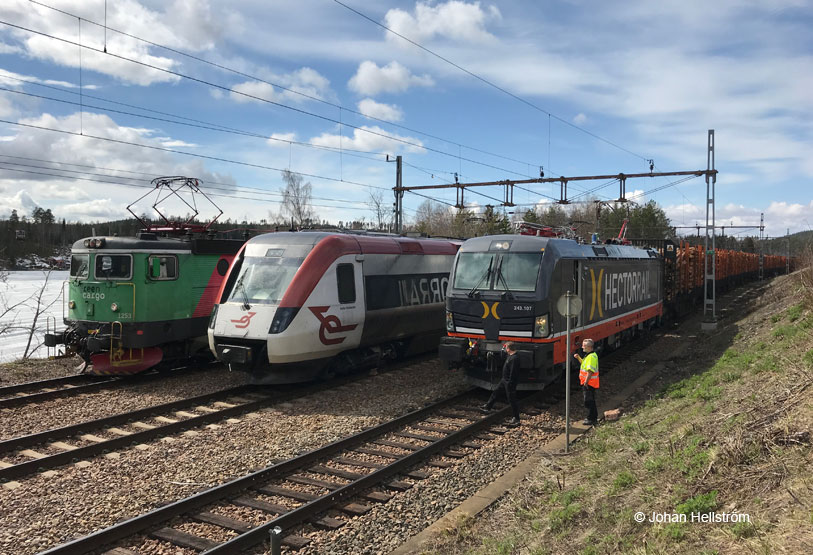
On my own driver assessment on the 27 April 2018, I drove a "Trätåg" Borlänge to Gävle timber train. At the Ryggen passing loop (east of Falun), we had a "three train meeting". Left the Green Cargo Borlänge to Luleå "Steel commuter", in the middle the passing "TiB-Regina" regional EMU, and our train to the right.
The IC-train 41 for Stockholm, headed by Rc6 1390, is ready to depart from Mora in the cold and beautiful morning on 7 April 2009.
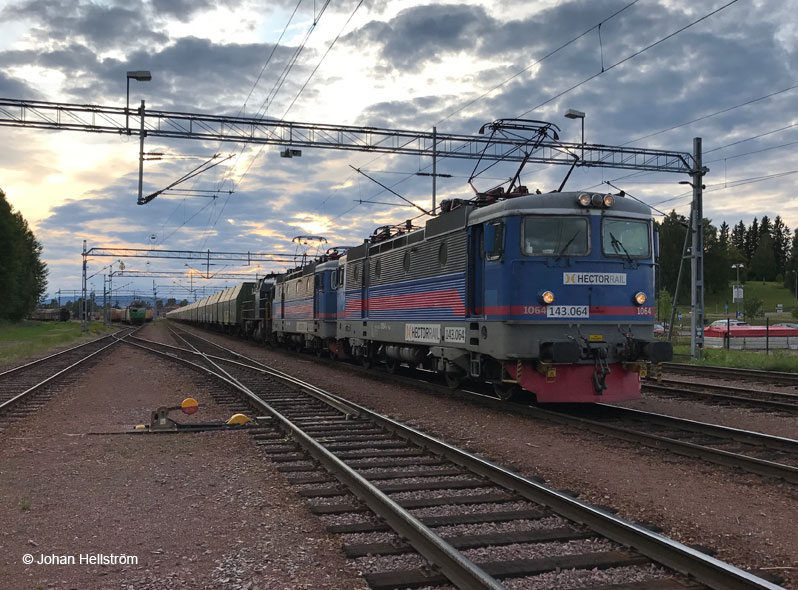
My train 40049 stands ready for departure to Stockholm in Mora in the evening on the 24 August 2017.
Westbound
A special appointment (and train) was the Venice Simplon-Orient-Express (VSOE), which I drove on the 12 April 2013. Here, we are standing in the passing loop at Järna, awaiting a couple of faster trains to pass.
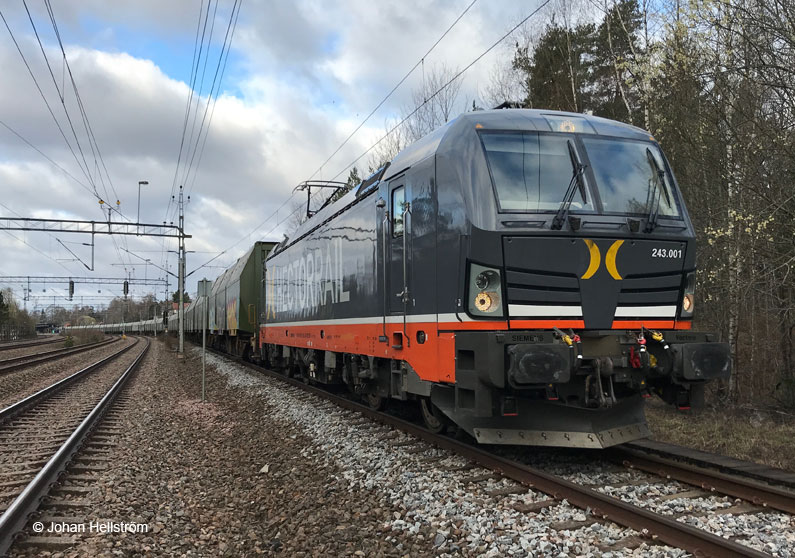
On the 24 April 2018, I was originally rostered for a "Mora-roundtrip", but due to different reasons, I had to pick up the Fortum woodchip train in Järna instead. It was stabled there due to track works. It was actually the first time I drove a Vectron in a freight train after my loco training.
On the way to Gothenburg with the IC 101 on the 16 April 2012, I passed a X2 train at the lake Skillöt, short before Gnesta.
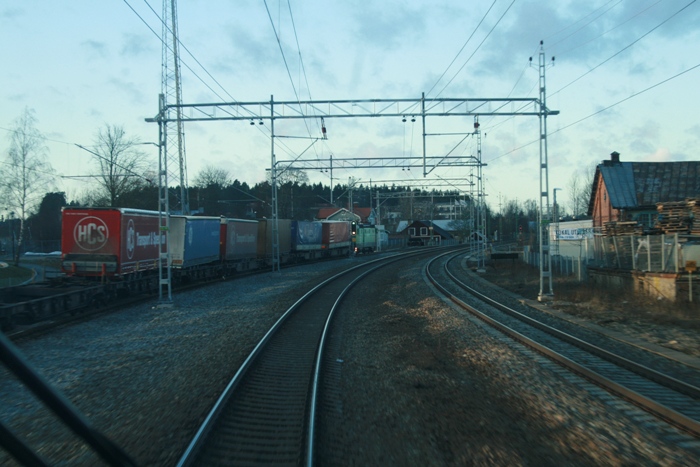
On 11 January 2008, our Stockholm to Gothenburg X2000 service 435 passes the Green
Cargo intermodal train 42913 in Gnesta. The freight train was delayed on this particular
day; normally the 42913 passes Katrineholm before the
X2000 service 435 passes that station. Intermodal transports are by the way a smart way of reducing long-distance freight traffic
on the roads; the lorry trailer or the container takes the train (or the boat)
on the long way, and the lorry on the short way.
Passing the SJ 3000 624 between Björnlunda and Stjärnhov on the 25 September 2013.
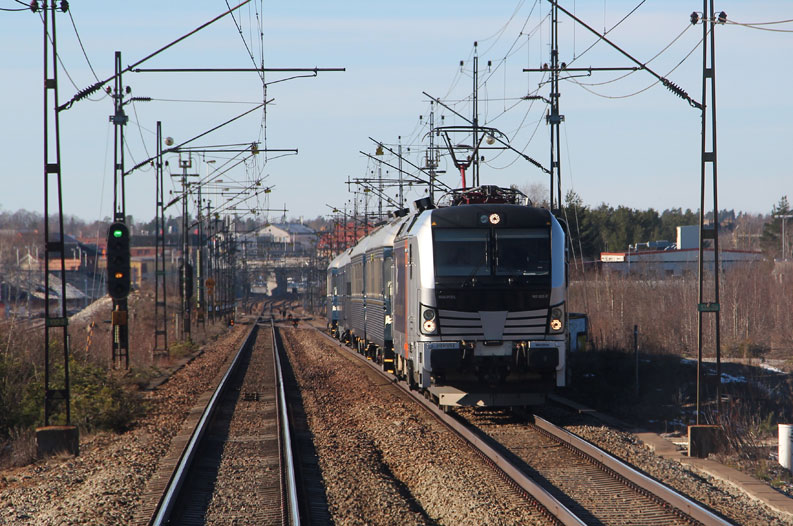
On the 5 March 2015, we passed the "Blå Tåget" (Blue Train) in Katrieholm.
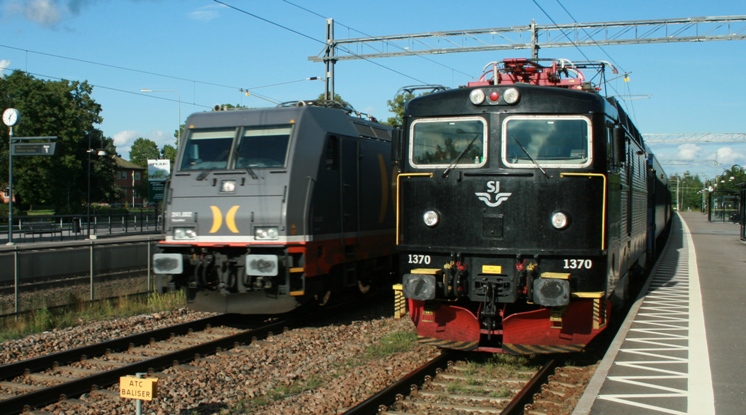
The summer holidays were over for this year, and the work began again.
6 August 2008 was maybe not the best day for the Swedish railways. Here, Hector Rail's freight
train 41807, pulled by 241 002 Skywalker, passes my much delayed IC 639
Stockholm to Karlstad train in Vingåker. I became an ATC-fault
on my Rc6-loco 1370 between Björnlunda and Stjärnhov, hence I had to run at reduced speed (80 km/h) to Hallberg, were the locomotives were changed. We
arrived at Karlstad exactly 2 hours late. Yet another day at the railway!
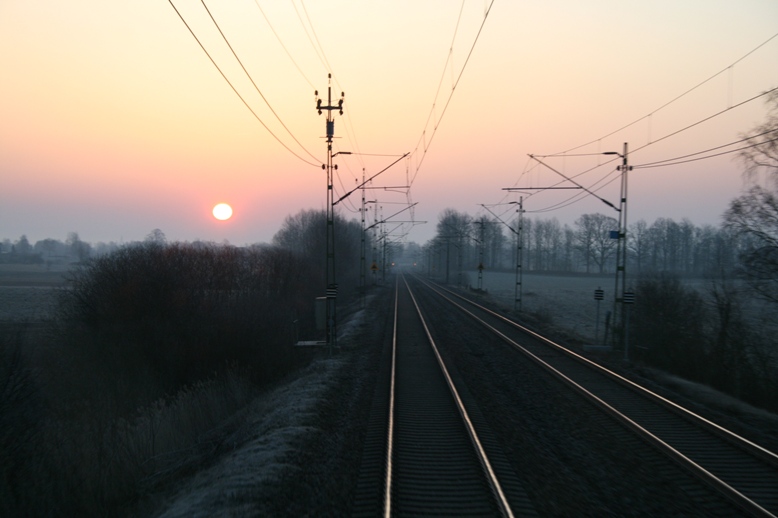
The Western Main Line seen from the driver’s seat.
Sunrise between Högsjö and Vingåker on 28 March 2007.
Sweden's largest marshalling yard is situated in Hallsberg.
The rebuilding works were finished some years ago.
One can see the new marshalling tower in the middle of the picture.
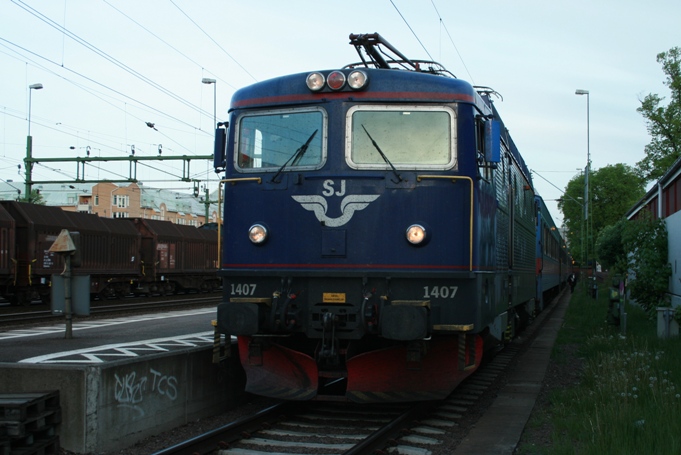
We're taking a short detour to the Värmland county!
In the morning on 13 May 2008, Rc6 1407 stands on track 20 in Karlstad,
heading the 06:00 Karlstad to Stockholm C IC working 622. The trainees have prepared the loco and the
conductor checks the brakes. During our trip to Stockholm, the trainees
experienced several disturbances; unexpected passing a signal at ‘danger’ (in Svartå), signal problems in Laxå as well as speed reduction without signs and balises (then called
a '§ 28:5 speed reduction') in Katrineholm. If we were
delayed? Well, yes, about half an hour… I’m personally very found of this dark
blue livery, but I also like the new black one.
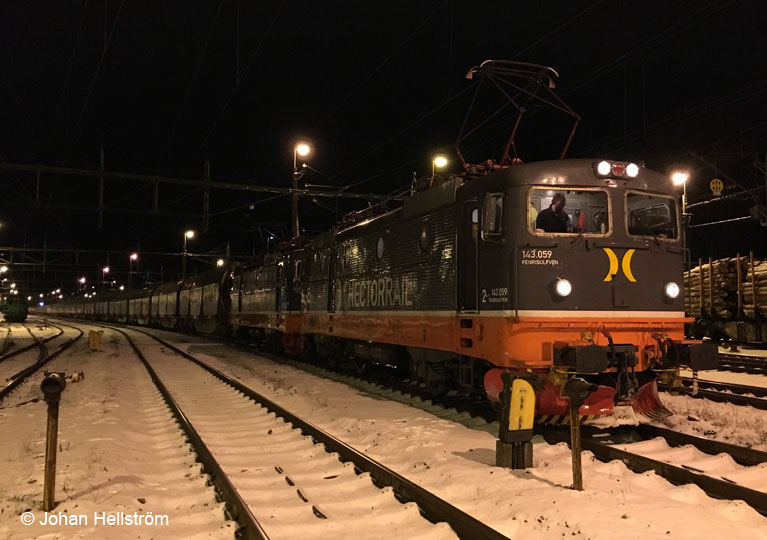
On the 6 February 2017, it was finally time again for me to drive a train again! This time I drove the "Fortum"-train 48984 from Kil (west of Karlstad) to Värtan in Stockholm. The train was hauled by the two Hector Rail-livered 143's (former SJ Rc3) 143.059 Fenrisulfven and 143.060 Jernsida. Here, we are ready for departure in Kil.
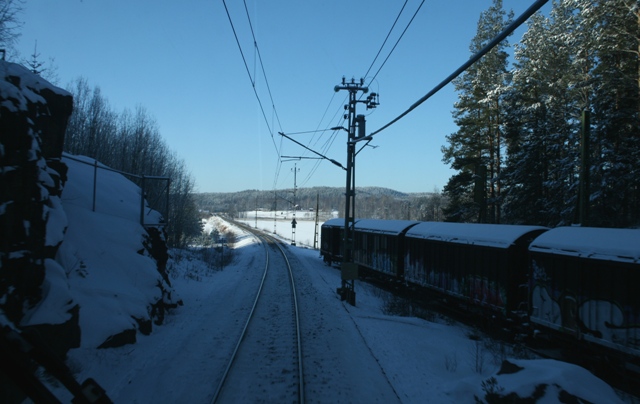
A new line and tunnel is built at the Brunnsberg Tunnel between Kil and Arvika.
The old tunnel and line is now used as a siding.
Shortly after entering daylight again, the railway line crosses the lake Värmeln on a long bank. The view is fantastic!
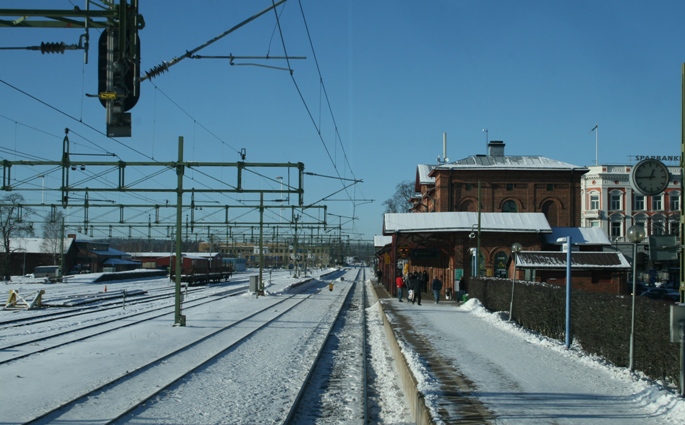
Entering the Arvika station on the sunny winter day, 12 February 2009.
I was gaining route knowledge that day.
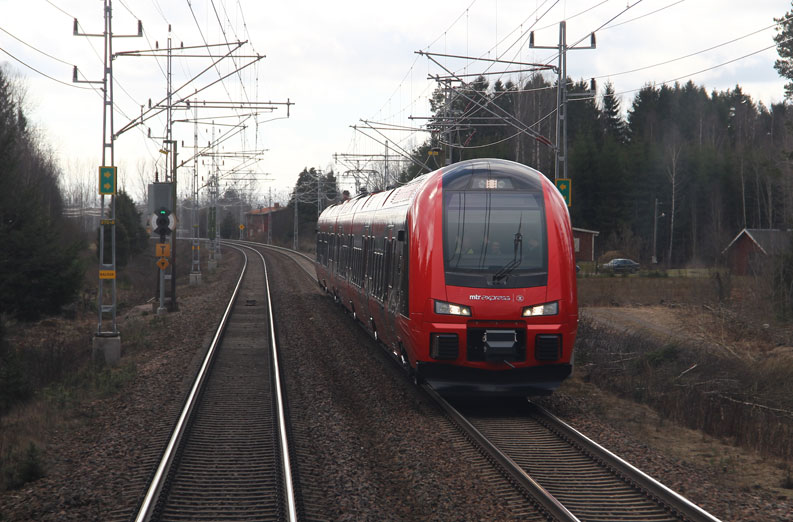
Back to the Western Main Line. This was a historic moment! For the first time, two MTRX trains passed eachother on thr 6 March 2015, just outside Töreboda. We drove the X74 74003 in train 2029, and our colleagues drove the X74 74003 in train 2032.
Back to the Western Main Line.
The bridge over the Göta Canal at Töreboda, on the 15 January 2007.
The stretched line between Töreboda and Skövde is sometimes used for high speed test runs.
The new Swedish speed record 303 km/h was taken on 14 September 2008 the summer 2008 with the
'Regina'-EMU X52 9062, as a part of the project ‘Gröna Tåget' (the Green Train).
On the 12 April 2012, I drove the IC 101 to Gothenburg again. In Skövde, we were passed by the SJ 2000 425.
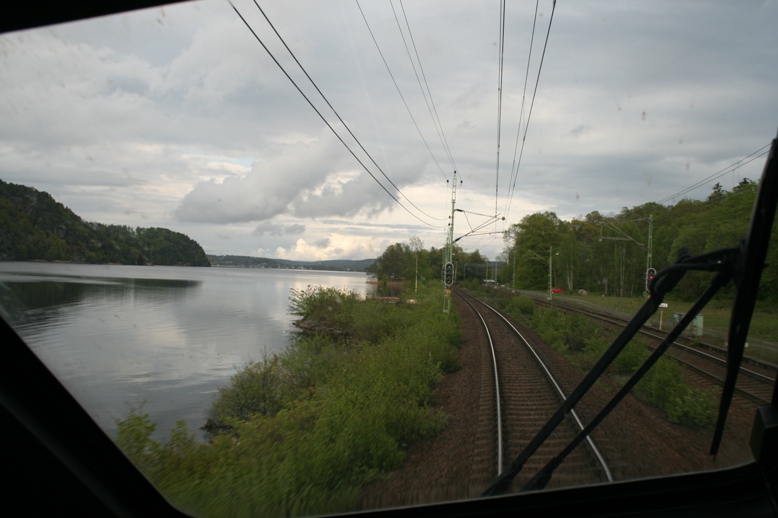
Driver’s view; The Western Main Line ('Västra Stambanan') at Jonsered,
northeast of Gothenburg, on 11 May 2007.
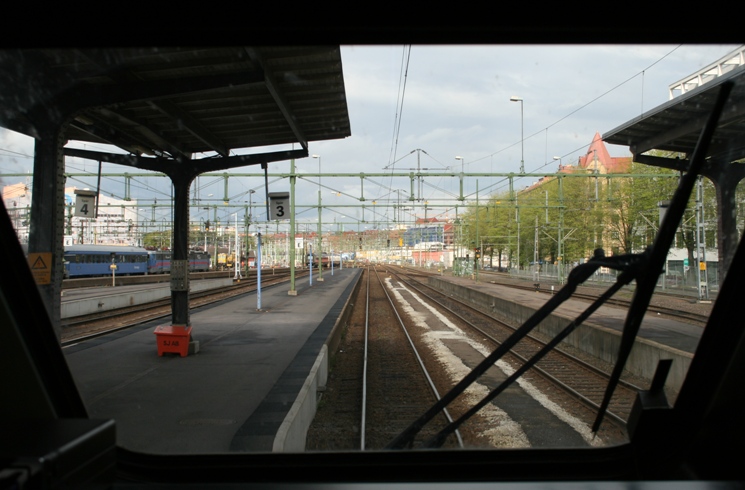
Gothenburg central station seen from the driver’s cab in the
driving trailer UB2X 2516, earlier the same day. I was about to drive the
Gothenburg to Stockholm X2000 working 444.
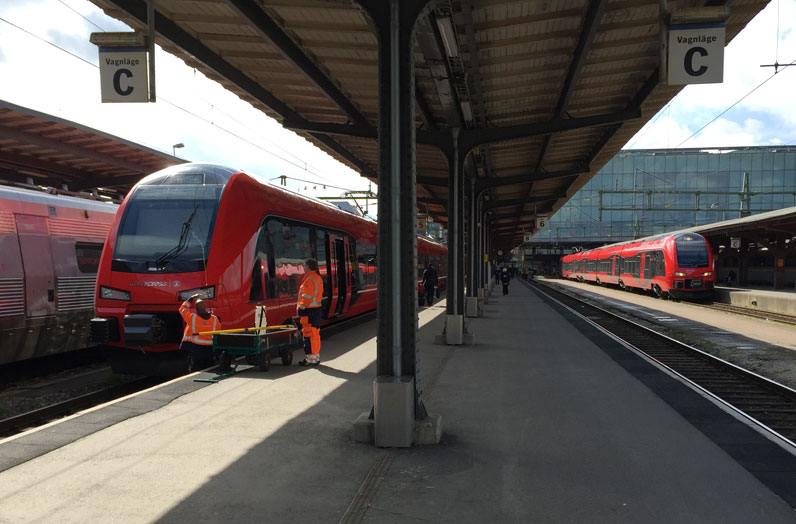
High MTRX presence at the Gothenburg main station on the 29 April 2015. To the left the X74 74003 on track 5, which I just before arrived with as train 12031 from Stockholm. To the right the X74 74002 on track 7, ready for departure to Stockholm C in train 2040. The windscreen is bein washed during the halt.
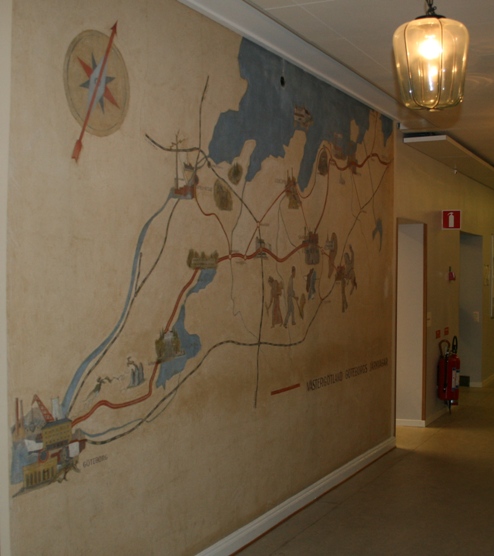
In Gothenburg, SJ is located in the so called VGJ House,
once the station and office building for the
narrow gauge private railway 'Västergötland-Göteborgs Järnvägar. On one of the walls in the refurbished
building, one finds this beautiful map over the former VGJ network.
Two parts of the former network are today heritage lines; Anten-Gräfnäs
Järnväg and Skara-Lundsbrunns
Järnväg.
Southbound
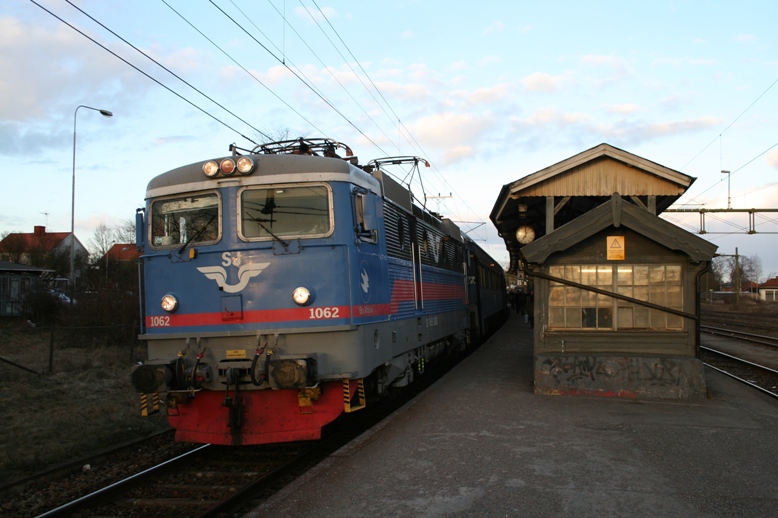
The Stockholm to Norrköping via Nyköping regional working 263 headed by Rc3 1062, calls at Nyköping on 3 April 2007.
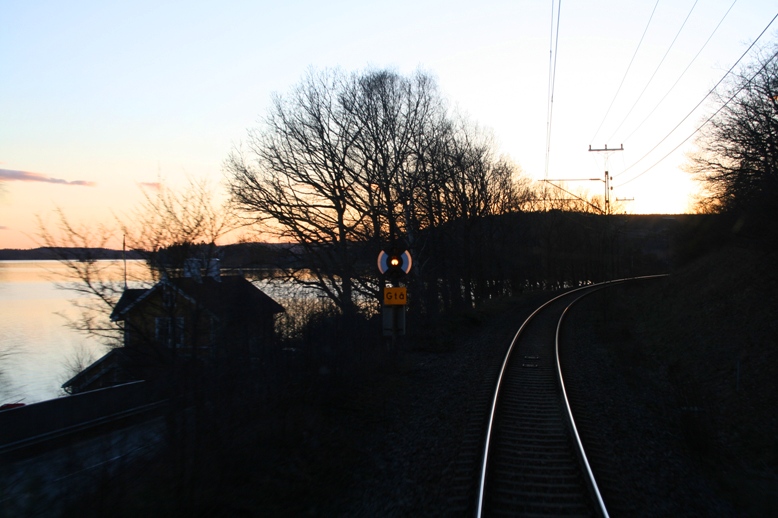
The Nyköping line along the Bråviken Bay between Åby and Kolmården is a very beautiful one. The sun had
just gone as I approach the distant signal in Getå on 3 April 2007.
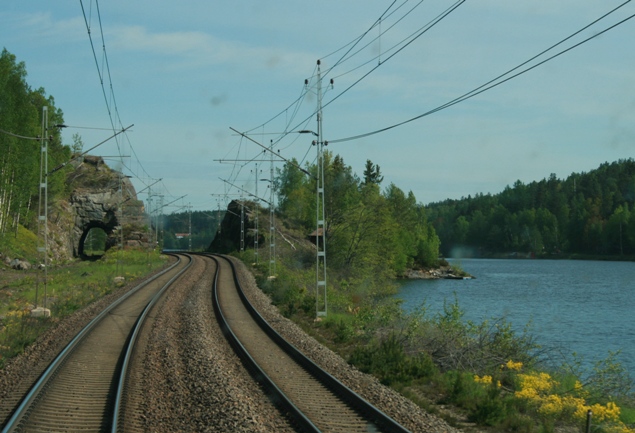
A bit further north of Åby, after passing Graversfors, the Southern Main Line follows the lake Näknen.
Here, Banverket has fulfilled the ‘tree securing’, which means
that trackside trees and bushes closest to the line have been removed, to
minimise the risk of trees falling down on the over-head catenaries in case of
a storm. To the left, one can see the old single-track tunnel from the late 19th
century, that was abandoned as the double track line was completed in the
1960’s.
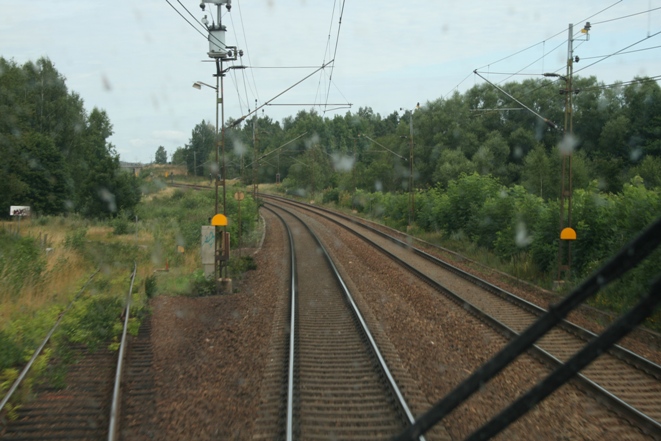
New shunting limit signs according to the new Swedish rail safety regulations (JTF) in Norrköping.
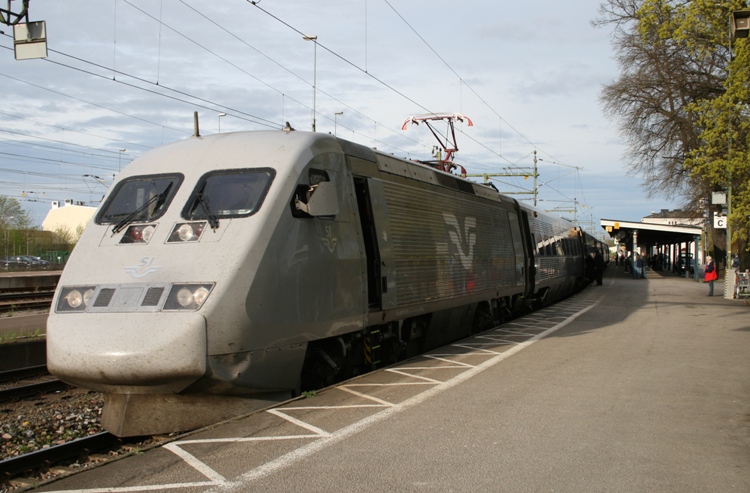
The X2000 Stockholm to Malmö working 543 calls at Norrköping on 29 April 2007.
The train is hauled by the power car X2 2022. Recently, the last X2000-unit was rebuilt and modernised.
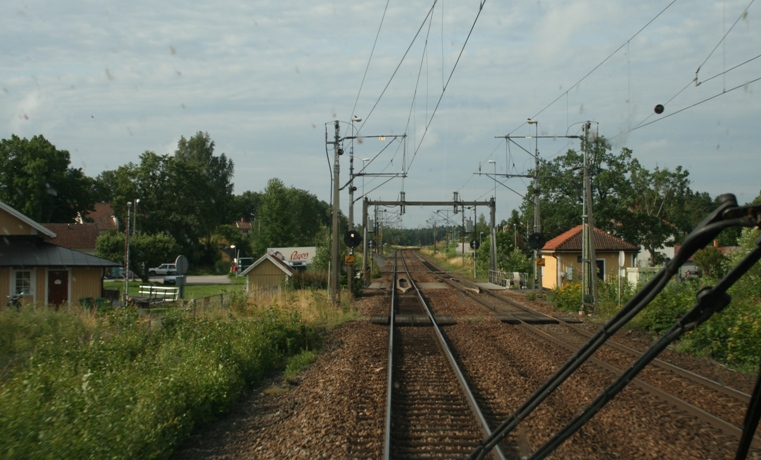
Norsholm on 3 August 2009. Here, the Southern Main Line crosses over the Göta Canal.
The Bridge Signal shows a white light, and confirms that the bridge is down and locked.
Busy times at Linköping C on 22 January 2010.
From the left to the right:
The Stockholm to Malmö X2000-Service 523,
the Malmö to Stockholm X2000-Service 524 (unusually with the power unit X2K 2040 in the northen front),
the Östgötapendel commuter train 8721 for Mjölby and the regional train 226, leaving just after the X2000 524, bound for Gävle via Nyköping and Stockholm.
Train 251, a Stockholm to Linköping via Nyköping regional service is seen here at the yard in Linköping after
being taken out of service. After a couple of hours sleep, I drove back a Malmö to Stockholm
night train service.
Passing the SJ 2000 513 on its way to Jönköping at Mantorp on the 23 April 2014.
On 11 January 2007, I passed by the Gripenberg Castle (above to the right), with the Malmö to Stockholm X2000-Service 526.
It is the largest wooden castle in Sweden, built in barock style during the 1660s for the Field Marshall and Count Carl Gustav Wrangel.
Morning in Jönköping on 29 August 2006. Our
X2000-unit, with the power car X2 2024 at front, is ready for departure to Stockholm via Nässjö.
An X2000 Special at Kristianstad C on 4 April 2009.
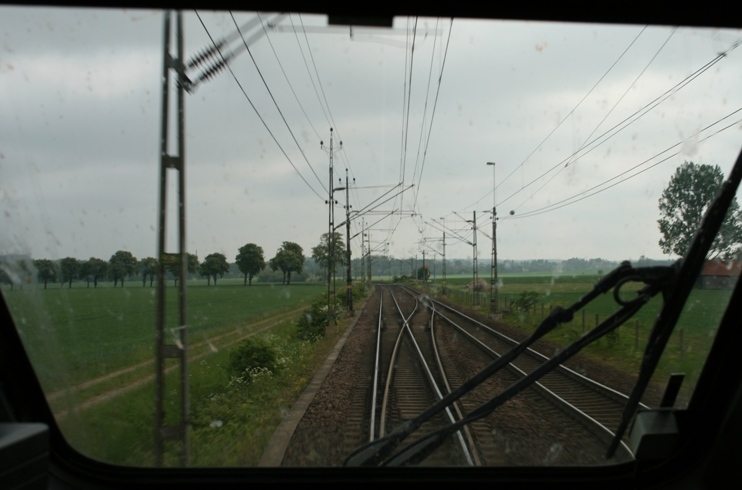
The crossover at Dammstorp on the Southern Main Line between Örtofta and Eslöv in Skåne (Scania) is passed by at line speed on 26 May 2007.
Between Lund and Malmö the rail traffic is intense. On the 23 April 2014 we met a northbound Pågatåg just outside Lund.
Malmö C on 4 December 2006.
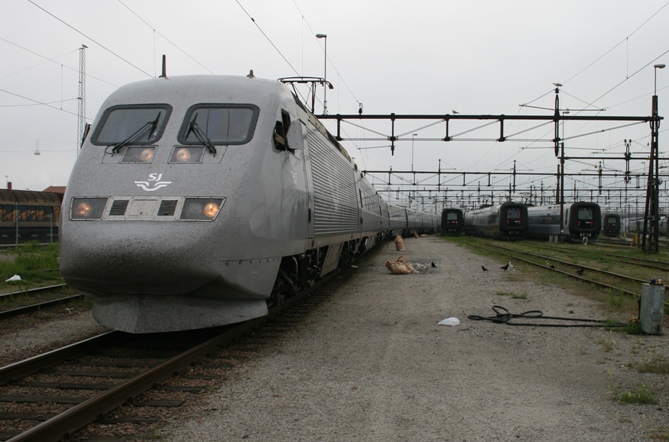
Another picture from Malmö, taken on 23 May 2007.
I have finished my preparation of the X2000 train
set 5 (driving unit X2 2005 with belonging coaches and driving trailer), and
shortly after, the train set was driven down to the platform to be the Malmö to Stockholm X2000 working 526.
To the left, one can see a Nordwaggon-wagon.
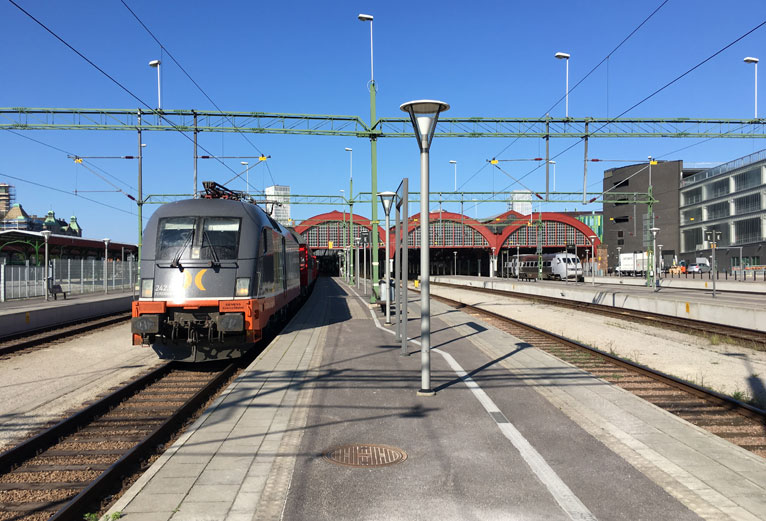
Malmö C on the 13 May 2016. The Hector-Tauri hauled also passenger trains, in this case the "Snälltåget"-trains between Stockholm and Malmö. Here, the train 3940 is ready for departure. Unfortunately, we lost the contract, as Transdev took over the "Snälltåget" services in October 2016 and runs it since in own regime.
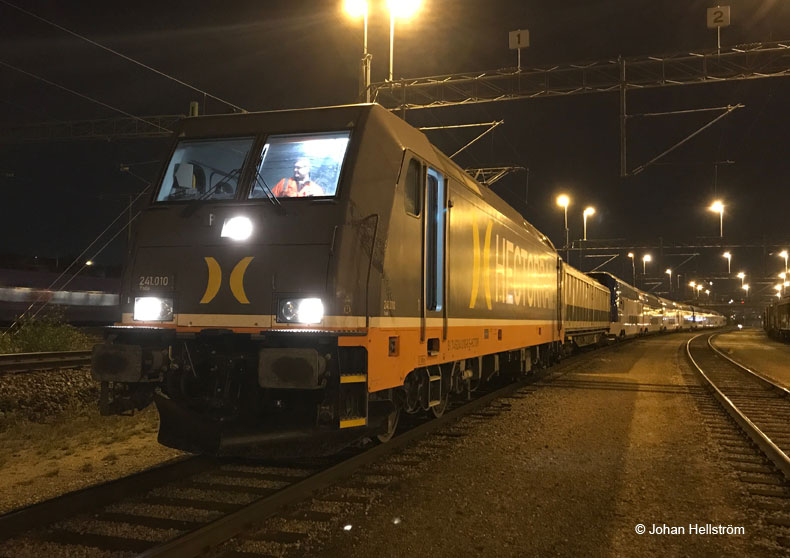
On the 10-11 October 2018, I drove a transport of two Mälartåg-EMUs (Stadler DOSTO); a bit different and nice appointment. I released my Danish colleague in the Malmö shunting yard, and drove first up to Hallsberg and stayed over-night there, and continued the day after further on to Tillberga. It was abaut a year after I last time drove a Traxx-loco.
SKÅJ
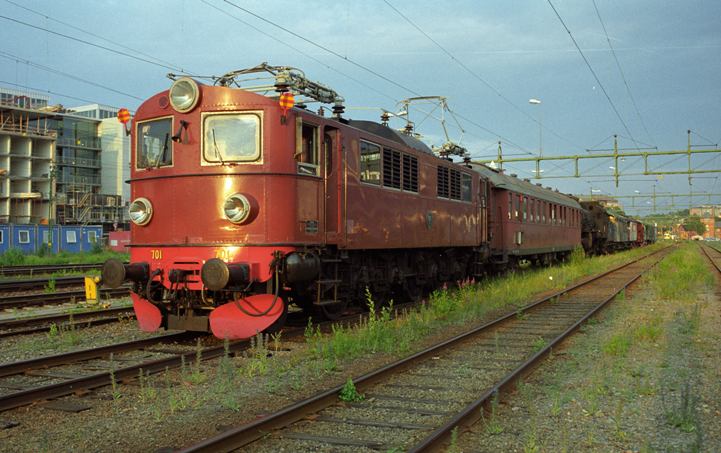
I’m also member of the preservation society SKÅJ, so that I can gain training on elderly (electrical)
locomotives. Here stands F 701 (1’Do’1’) after finished shunting training at
Sundbyberg on 18 June 2002.
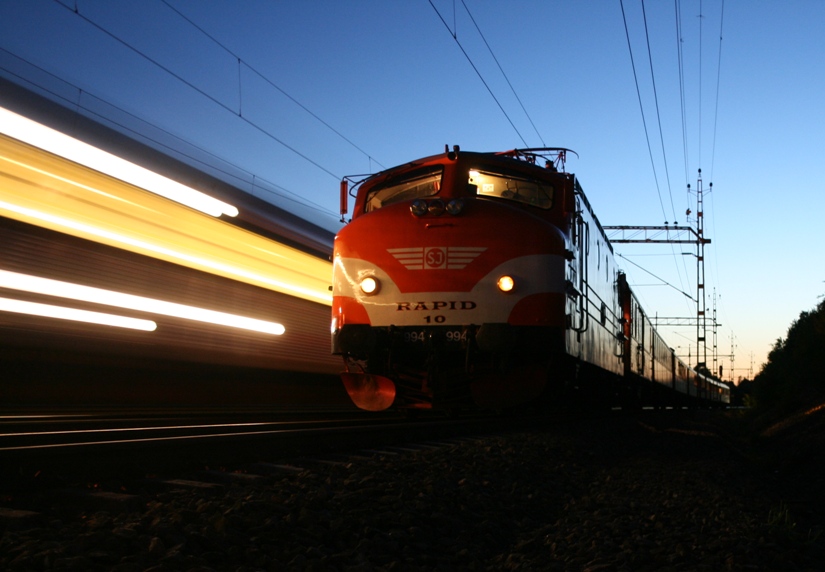
In the beginning of June 2007, I was qualified on one of SKÅJ’s other locos, the Ra 994 (so called Rapid-loco).
We’re waiting here on a siding in Rosersberg in the summer night, as a Märsta to Stockholm C commuter service passed by.
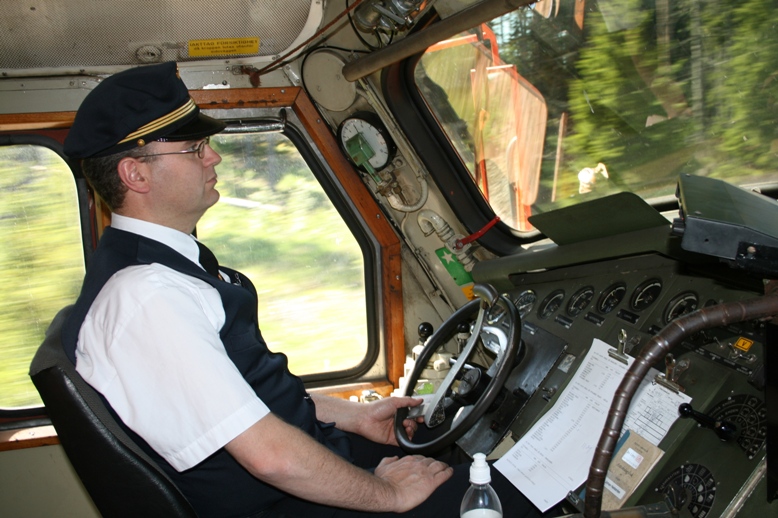
Me in the driver's cab on the Ra 994.
Train meeting and passing by in Mariedamm, between Hallsberg and Motala on 3 June 2009.
We've just met one of DB Schenker Rail's Hamburg-Maschen to Hallsberg freight trains, hauled by an EG-Loco.
Then we needed to wait for the 'TiB-Regina' EMU for Mjölby to pass by, before we could continue our journey.